
01590 672014 VHF CHANNEL 66 - Not 24 Hour Call Sign: Lymington Harbour


News and Events Menu
- News & Events
- Local Events
- Events Calendar
- Newsletters
Royal Lymington Yacht Club Open Day
Representatives from many areas of the club will be on hand during the Open Day to show visitors around and a selection of members’ boats will be available to view.
10:00 to 14:00 - Discover the Club's history in their centenary year - Learn about the regular keel boat and dinghy racing - Discover Junior sailing opportunities - Take part in yacht and motor cruises, rallies, meets and socials in the Solent and beyond
And of course, all the benefits of becoming a member of Royal Lymington Yacht Club!
To find out more, click HERE .
Get in touch
Lymington Harbour Commissioners Harbour Office, Bath Road, Lymington Hampshire, SO41 3SE
T: 01590 672014 E: [email protected]
VHF: Channel 66 Call sign: 'Lymington Harbour' (office hours)
Office Opening Times
April to September 08.30 to 17.00 (7 days) October to March 08.30 to 17.00 (Weekdays)
In Event of a Marine Emergency
Call 999 & ask for the Coastguard
Follow us on
To view our location map please click here
Copyright Lymington Harbour Commissioners 2019 all rights reserved.
Site design and build by netguides

- CLASSIFIEDS
- NEWSLETTERS
- SUBMIT NEWS

- Latest videos, from 2023

- Meet the Team
- Shoreside Facilities
- Weather & Tides
- Marina Directory
- Visitor Berthing
- Annual & Seasonal Berthing
- Dry Berthing
- Winter Berthing
- Berthing Rates
- Club Membership
- Boat Club FAQ
- Boatyard Services
- Winter Lay Up
- Boatyard Rates
- Contractor Registration
- Get on the Water
- Cruising Destinations
- Explore Lymington
- Getting Here
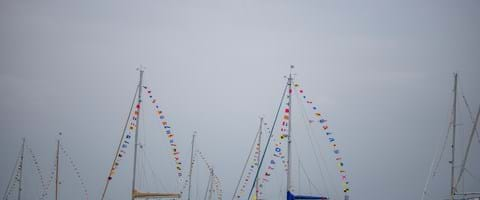
Royal Lymington Yacht Club celebrates centenary with Royal visit
On Saturday 18th June, Her Royal Highness The Princess Royal visited the Royal Lymington Yacht Club (RLymYC) for an impressive Regatta Day celebrating the Club’s centenary.
The Princess Royal has taken a particular interest in young people's sailing and training, as well as sailing for disabled people. She most recently visited Royal Lymington in 2019 to celebrate the 35th anniversary of Wednesday Junior Sailing, the Club’s community sailing programme, which is in many ways the “Jewel in the Crown” of the Club’s achievements. This unique project was started by a group of members to benefit local children interested in learning to sail who might otherwise not have the opportunity and the project has been proudly supported by Lymington Yacht Haven for over 35 years .
The Centenary Regatta Day and ‘Après Sail Festival’ brought together members of all ages, their families and friends for a glorious celebration of one hundred years on the water. Flotillas of yachts, dinghies, motor boats and paddle craft took part in a wide variety of events during the day. Afterwards, members returned ashore for food, drinks, live music and fun activities including a Centenary Haybale Games on the green adjacent to the clubhouse.
RLymYC Commodore, Phil Lawrence, said: “We were honoured that our Patron, HRH The Princess Royal, was able to join over 800 members of all ages for our Centenary Regatta Day. We celebrated one hundred years of the Royal Lymington Yacht Club with a packed day of activities afloat and ashore.”
"Out on the water Princess Anne reviewed our fleet of members’ yachts and powerboats, many of which were dressed overall to celebrate the day. Keelboats raced for our prestigious PotterShip Trophy and the dinghy fleet raced in the boisterous conditions. Many of our junior sailors were delighted to meet the Princess as she watched them learning the joys of boating.”
"Back ashore, dozens of Club volunteers delivered a tremendous festival with food and drink, live music and fun activities on the green. It was fantastic to see so many members with a shared passion for boating - from the very youngest to those with over 50 years of membership enjoying the celebrations.”
“We were delighted to showcase to Her Royal Highness the enormous range of varied activities and excellent facilities the Club has to offer. Whether your passion is motor cruisers, yachts, dinghies or paddle boards, junior sailing and training or a thriving social scene, the Royal Lymington Yacht Club has something for everyone.”
Patron of the Club since 1979, the Princess was welcomed by Her Majesty’s Lord-Lieutenant of Hampshire, Mr. Nigel Atkinson, New Forest District Council’s Vice-Chairman, Councillor Neville Penman, Mayor of Lymington, Councillor James Hoare, and the Club’s Commodore, Phil Lawrence.
The Princess Royal was introduced to Club’s Flag Officers, Centenary Regatta organisers and a number of young sailors, before heading out on the water in a RIB to tour the Regatta.
A spectacular fleet of members’ yachts dressed overall in nautical flags and motor cruisers anchored in lines on the Solent adjacent to the Club’s Starting Platform for a Fleet Review by Her Royal Highness.
The Princess Royal then took the opportunity to watch the prestigious PotterShip Race, an annual event where members compete for the glittering PotterShip Trophy, given by the Club’s founder, Major Cyril Potter, in 1937.
After watching the start for the XOD boats, which have been raced out of the Club throughout its one hundred year history, the Princess Royal was treated to an impressive ‘fly-past’ by young Club member, Hattie Rogers in her foiling Waszp dinghy, in which she was recently crowned SailGP Inspire Female World Champion. Hattie said: “The Centenary Regatta was a complete celebration of all types of racing and cruising. To sail in front of Her Royal Highness was an honour and very memorable.”
Whilst out on the water, Her Royal Highness was introduced to the race and safety officials and watched the dinghy racing, where junior, youth and adult sailors were racing in windy conditions a lot stronger than originally forecast.
The Princess Royal then had the opportunity to watch the Club’s youngest sailors in more sheltered water closer to shore; a colourful display of pottering Lymington River Scows brightening up the grey sky. Her Royal Highness waved to the youngsters and showed a great interest in the Club’s adventure sailing ‘Shipmates’ and ‘Mariners’ fleets and enjoyed seeing the two Club Boatmen, dressed as ice creams, handing out ice lollies to the delighted children.
The Royal Lymington Yacht Club is one of the most active ‘Royal’ Clubs, founded in the hopeful days after the first World War. Royal status was bestowed on the Club in 1936, which complemented the Royal patronage of the Club since 1925. The First Patron was HRH Prince Henry, Duke of Gloucester, the uncle of HM The Queen.
Since becoming Patron of the Club in 1979, HRH The Princess Royal has made numerous working visits to the Club, including joining the crew in the ladies championship event, participating in RIB support of junior racing, and attending key events in the life of the Club, such as the commissioning of the new pontoon in 2016. The Princess Royal has been an enthusiastic visitor to the Club’s special occasions and for a while kept her yacht on the river close to the Club.
The Royal Lymington Yacht Club is considered very much a home of yachting, dinghy sailing and motor boating - bringing together likeminded people with a love of the sea. Find more information about the Club at rlymyc.org.uk. The Club continues to welcome new members, contact [email protected] or call 01590 672677.
Photo courtesy of Sportography
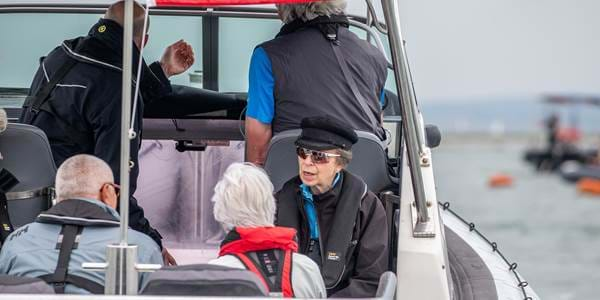

- CLASSIFIEDS
- NEWSLETTERS
- SUBMIT NEWS

Boats for sale
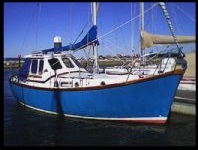
Local Children Funded to Develop Sailing Skills and Confidence at Royal Lymington
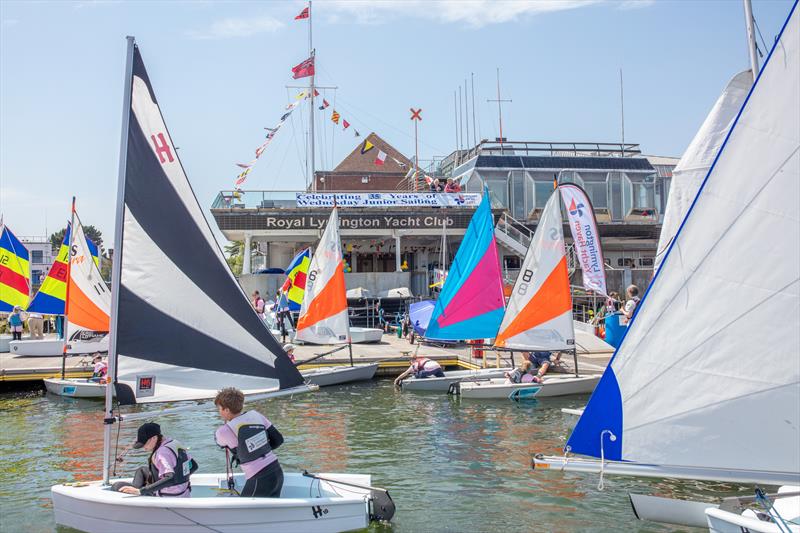
Related Articles
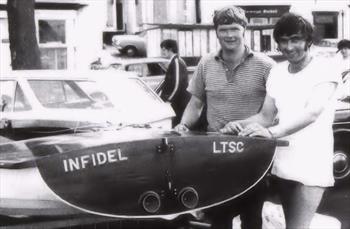
Upcoming Events
- Napoleonic Wars 200
- The Royal Navy in the First World War

Napoleon’s Retreat from Moscow to Smolensk
The previous post in this series described how Napoleon decided to retreat from Moscow on 18 October 1812. His intention was to make for the supply depot at Smolensk by a southerly route. This might require a battle with Mikhail Kutuzov’s Russian army, but would mean that the French were not moving through the territory that had been ravaged in their advance on Moscow.
The Grande Armée set off on 19 October, moving south west towards Kaluga. The main body took the older of the two roads to Kaluga, with Prince Eugene’s IV Corps taking the newer road, which was further to the west. Napoleon ordered Marsahl Edouard Mortier , commander of the French rearguard, to destroy the Kremlin before withdrawing on 23 October. The French demolition charges did not work properly, damaging but not destroying the Kremlin.
According to David Chandler, Napoleon had told his men that he intended to attack Kutuzov’s left flank, realising that this news would reach the Russians. He hoped that Kutuzov would consequently move to the east and allow the French to escape to Smolensk. [1]
Adam Zamoyski speculates that Napoleon may have intended to attack the Russians, with Eugene launching a flanking manoeuvre. If Napoleon did consider this, he changed his mind, since on 21 October the main French army moved to join Eugene on the new road. [2]
Kutuzov was quickly informed that the French had left Moscow, but was slow to move. General Dimitry Dokhturov learnt from prisoners that the Grande Armée corps was heading for the road junction at Maloyaroslavets . The French would threaten the flanks and supply lines of the Russian army if they took the junction, so Dokhturov moved his corps there. Control of Maloyaroslavets would give mean that Napoleon could proceed to Smolensk via either Medyn or Kaluga
General Alexis Delzons’s 13th Division reached Maloyaroslavets ahead of Dokhturov, but Delzons left only two battalions in the town. Dokhturov’s corps attacked at dawn on 24 October, taking the town and forcing Delzons to retreat back across the river.
Delzons launched a counter-attack and forced the Russians back. The Croatians of the 1st Illyrian Regiment did particularly well. Kutuzov’s leading corps, under General Nikolai Raevsky , arrived and re-captured the town. General Domenico Pino’s 15th (Italian) Division then took it back. The Russians fell back, but took up a position that covered the bridges over the river.
By 1pm most of the Grande Armée was drawn up on the north back, but Napoleon decided not to send it across the river because the well-positioned Russian artillery would have inflicted heavy casualties on it as it moved.
Fierce fighting continued in the town for the rest of the day and the Italians held it at nightfall. General Sir Robert Wilson , a British observer with the Russian army, wrote that:
The Italian army had displayed qualities which entitled it evermore to take rank amongst the bravest troops in Europe. [3]
The action had involved 27,000 soldiers and 72 guns of the Grande Armée against 32,000 Russians with 354 guns. Napoleon had lost 6,000 men, including Delzons. Russian casualties were higher, but they could be replaced. Napoleon now had only about 65,000 men with him, facing 90,000 Russians with 500 guns.
Early on the 25 October Napoleon carried out a reconnaissance of the battlefield. He was nearly captured by Cossacks, but his escort fought them off. Baron Agathon Fain , his secretary, said that the Emperor was badly affected by the sight of the corpses on the battlefield, many of whom had been burnt to death. [4]
Kutuzov had withdrawn two kilometres to a new position. Attacking it might result in a decisive French victory, but casualties would be heavy. The Russian withdrawal had opened up the route to Smolensk via Medyn, but taking this route would mean that the Grande Armée would be closely pursued by the Russians all the way to Smolensk.
Napoleon therefore decided to retire and head for Smolensk via the route that the Grande Armée had originally advanced along.
Zamoyski points out that Kutuzov, concerned about the inexperience of his troops, was reluctant to fight a pitched battle with the Grande Armée . He suggests that if Napoleon had moved boldly, he could have reached Medyn, where supplies were available, joined up with General Louis Baraguay d’Hilliers’s division and reached Smolensk by 3 or 4 November. [5]
Chandler argues that Napoleon’s plan to defeat Kutuzov before heading to Smolensk via Kaluga was the best option open to him. Changing his plan now meant that six days had been wasted. He could still have headed for Smolensk via Medyn, but reverting to the original line of advance ‘was to court disaster.’ [6] Charles Esdaile calls Maloyaroslavets a ‘pointless battle’ [7] for the French as it wasted a lot of time.
The Grande Armée marched along a single road, meaning that those further back had to march through ground churned up by those ahead of them. The horses were in poor condition, so it was hard for them to pull guns and wagons. Some generals wanted to speed up the column by abandoning part of the artillery, but Napoleon refused, as he argued that he was making a tactical withdrawal rather than retreating.
On 28 October the head of the column reached the battlefield of Borodino. The corpses had not been cleared away, and large numbers of French wounded had not been evacuated. Napoleon ordered that they should be taken along, against the advice of his Surgeon-General, Baron Dominique Jean Larrey and other doctors. Few survived the retreat.
Napoleon reached Vyazma on 1 November. He reached despatches that informed him that things were going badly on his flanks. In the south the Austrian Prince Karl Schwarzenberg was withdrawing towards the River Bug, exposing Napoleon’s flank. In the North a Franco-Bavarian army under Marshal Laurent St Cyr had been forced to retreat from Polotsk
St Cyr had been promoted to Marshal after the First Battle of Polotsk on 18 August 1812, in which he took over from the wounded Marshal Charles Oudinot and defeated Prince Peter Wittgenstein’s Russian army.
On 18 October Wittgenstein, who had been reinforced and now outnumbered St Cyr, launched a new attack on St Cyr at Polotsk . The Franco-Bavarians held off the attack on the first day; casualties on both sides were heavy. St Cyr realised late the next day that he was in danger of being encircled. A Bavarian counter-attack on 20 October enabled the Franco-Bavarian force to withdraw, but the road to the French supply base at Vitebsk was opened.
The retreat continued, with the column being pressured by both Cossacks and Kutuzov’s advance guard, commanded by Count Mikhail Miloradovich . On 3 November Miloradovich attacked the Grande Armée’s rearguard, Marshal Louis Davout’s I Corps, to the east of Vyazma .
Davout received support from Eugene’s IV Corps and Marshal Josef Poniatowski’s IV Corps. The French suffered heavy casualties, but were able to fall back on Marshal Michel Ney’s III Corps. It had been left at Vyazma with orders to replace the I Corps as the rearguard once it was clear of the town.
French casualties were about 6,000 dead and wounded and 2,000 prisoners. Poniatowski, crushed beneath his horse, was amongst the wounded. Russian losses were at most 1,845. As well as human casualties, the Grande Armée suffered a loss of cohesion. Zamoyski argues that the Russians could have destroyed four French corps if Kutuzov had attacked with his full army. [8]
Until 3 November the retreat had taken place in reasonable weather. The temperature fell sharply on the night of 4-5 November, and the snow began on 6 November. Armies did not then normally campaign in the winter, so the French uniforms were completely inadequate for the Russian winter. Zamoyski describes how men out on fur coats and even women’s dresses that they had plundered from Moscow to take home to their womenfolk. [9]
Troops in units that retained their discipline and cohesion coped best. Stragglers, without comrades to help and support them, fared worse. The animals fared worse; deaths amongst horses meant that wagons and thus supplies had to be abandoned. Saul David’s recent BBC TV series on logistics and war, Bullets, Bombs and Bandages , explained that the French horses had the wrong type of shoes, which made it hard for them to walk on the snow and ice.
Napoleon continued to receive bad news as he retreated. On 6 November he was told that General Claude Malet , a patient at a sanatorium, had escaped and tried to launch a republican coup in Paris on 23 October, claiming that the Emperor was dead. It was quickly suppressed, but Malet had easily fooled some local commanders and Napoleon’s infant son and heir had received little support. The Emperor therefore decided that he needed to return to Paris as soon as possible.
The next day Napoleon learnt that Marshal Louis Victor had been forced to retreat after a battle with Wittgenstein at Czasniki on 31 October. The seriousness of the situation was shown by the phrasing of the order that Napoleon sent to Victor to attack Wittgenstein and re-capture Polotsk. Victor was told to:
Take the offensive – the safety of the whole army depends on you; every day’s delay can mean a calamity. The army’s cavalry is on foot because the cold has killed all the horses. [10]
Napoleon reached Smolensk on 9 November. It was four days before the whole of the retreating column arrived. The food stocks were lower than expected and this was compounded by looting. Chandler says that in three days the army ate supplies that could have been eked out to last a fortnight; it now comprised only 41,500 men. [11]
The Grande Armée did not stay long in Smolensk. Napoleon wanted to link up with Victor and Oudinot’s 25,000 men and considered wintering at his Vitebsk supply base. He did not know that the Russians had captured it on 7 November.
[1] D. Chandler, The Campaigns of Napoleon (London: Weidenfeld & Nicolson, 1966), p. 820.
[2] A. Zamoyski, 1812: Napoleon’s Fatal March on Moscow (London: HarperCollins, 2004), p. 369.
[3] Quoted in Ibid., p. 373.
[4] Ibid., p. 374.
[5] Ibid., pp. 375-77.
[6] Chandler, Campaigns , p. 823.
[7] C. J. Esdaile, Napoleon’s Wars: An International History, 1803-1815 (London: Allen Lane, 2007), p. 478.
[8] Zamoyski, 1812 , pp. 387-88.
[9] Ibid., pp. 391-92.
[10] Quoted in Chandler, Campaigns , p. 827.
[11] Ibid., pp. 827-28.
Share this:
Filed under War History
Tagged as 1812 Russian Campaign , France , French Army , Kutuzov , Maloyaroslavets , Napoleon , Napoleonic War , Polotsk , Russia , Russian Army , Vyazma
4 responses to “ Napoleon’s Retreat from Moscow to Smolensk ”
Pingback: The Battle of Krasny, November 1812. | War and Security
Pingback: Why Napoleon’s 1812 Russian Campaign Failed | War and Security
Pingback: DataViz History: Charles Minard’s Flow Map of Napoleon’s Russian Campaign of 1812 – Retreat from Moscow to Smolensk | Michael Sandberg's Data Visualization Blog
Pingback: What Minard’s Map Helps Show Us: Why Napoleon’s 1812 Russian Campaign Failed | Michael Sandberg's Data Visualization Blog
Leave a comment Cancel reply
This site uses Akismet to reduce spam. Learn how your comment data is processed .
- Search for:
Recent Posts
- British Troops Readied for Show of Force
- BBC News: UK to deploy Royal Navy ships to support Israel
- BBC: Rogue Russian pilot tried to shoot down RAF aircraft in 2022
- Aid to Ukraine: Storm Shadow Missiles
- It’s Like the First World War…If We kill them, they’re just replaced
Follow Blog via Email
Enter your email address to follow this blog and receive notifications of new posts by email.
Email Address:
- January 2024
- October 2023
- September 2023
- February 2023
- January 2023
- January 2022
- September 2021
- August 2021
- February 2021
- December 2020
- November 2020
- September 2020
- August 2020
- February 2019
- November 2018
- October 2018
- February 2018
- January 2018
- December 2017
- November 2017
- October 2017
- August 2017
- October 2016
- September 2016
- February 2016
- January 2016
- December 2015
- November 2015
- October 2015
- September 2015
- February 2015
- January 2015
- December 2014
- November 2014
- October 2014
- September 2014
- August 2014
- February 2014
- January 2014
- December 2013
- November 2013
- October 2013
- September 2013
- August 2013
- February 2013
- January 2013
- December 2012
- November 2012
- October 2012
- September 2012
- August 2012
- February 2012
- Current affairs
- Political History
- Uncategorized
- War History
- Entries feed
- Comments feed
- WordPress.com
BBC News – Home
- At least 60 killed in Moscow concert hall attack, Russia says
- Moscow concert hall attack videos examined
- Princess of Wales: I am having cancer treatment
- Kate cancer diagnosis rewrites story of past weeks
- Sick people leaving workforce at record highs
- Jordan North: How safe is vaping for my health?
- David Potts crowned winner of Celebrity Big Brother
- High rural house prices force locals into renting
- Chancellor says £100,000 not a huge salary in Surrey
- US call at UN for Gaza truce linked to hostages blocked
War and Security
- RSS - Posts
- RSS - Comments
- Battles and Book Reviews
- Birmingham on War
- Blog Them out of the Stone Age
- Civil Warriors
- Daly History Blog
- Forgotten Steel
- History Blog
- Kings of War
- Military History Blog
- Sharkey' s World
- Steven Gray's Blog
- Stoneman's Corner
- The Aerodrome
- The Home Front
- Think Defence
- Thoughts on Military History
Discussion Forums
- The Great War Forum
- World War 2 Talk
Follow me on Twitter

- Already have a WordPress.com account? Log in now.
- Subscribe Subscribed
- Copy shortlink
- Report this content
- View post in Reader
- Manage subscriptions
- Collapse this bar

Royal Lymington Yacht Club
The home of yachting, dinghy sailing and motor boating., new members are always welcome., join our regular keelboat and dinghy racing in a fantastic sailing area., motor boating, join regular motorboat cruises and meets with our growing power boat section., bar, restaurant and sun terrace, exquisite dining with stunning views at our popular bar and restaurant., join our day sails, weekend meets and longer cruises in the solent and beyond., younger sailors, our thriving junior and youth section inspires a life-long passion for sailing..
Royal Lymington Yacht Club welcomes new Members including experienced sailors and those new to the water.
We host regular keelboat and dinghy racing, Club events and large-scale National and International regattas.
For those who travel in a more relaxed manner afloat, our cruising section boasts a fine and varied selection of activities.
Join our growing power boat section on regular motor cruises.
Our Bar and Restaurant
Affordable and family-friendly bar and restaurant with spectacular views!
Junior and Youth
A prominent RYA training centre, we provide regular training courses, regattas, championships and events.
Our flexible space and stunning views are the perfect venue for conferences, celebrations and other events.
Our flexible space and stunning views are perfect for conferences, celebrations and other events.
Visiting the Club
How to find us by sea and by land, links to accommodation.
Our Centenary
In 2022 we will be celebrating 100 years of the Royal Lymington Yacht Club!
Weather and Tides
Member central.
Login to view your account and make a booking.
Upcoming Events

March 21, 2024
'I've started so I'll finish' - The farewell Tour!
After 18 years (and 10500 questions!) of Vince Sutherland hosting his fantastic Quiz, his very last quiz will be on Thursday 4th April. Register your team's entry and book your quiz night supper by Friday 29th March.

March 08, 2024
Mike Cowan: Oil Spill Response - Some of the Issues
It is with great pleasure that we announce the guest speaker for our Cruising winter lecture on Wednesday, March 20th. We are honoured to welcome Member Mike Cowan who will be delivering his talk titled 'Oil Spill Response; Some of the Issues'.

March 04, 2024
Thursday Night Racing is Back
Get ready to set sail into the exhilarating world of Thursday Night Racing, proudly sponsored by Spencers Coastal ! It's that time again to gear up for the ultimate weekly showdown on the western Solent.

March 06, 2024
Club Member India Syms Participating in the Ocean Globe Race.
Club Member India Syms is currently participating in the Ocean Globe Race as the Navigator aboard 'Outlaw' . They have recently completed an incredible 3rd leg. Read all about their journey.

February 13, 2024
Spring Series 2024
Exciting news, get ready to mark your calendars because the Spring Series is making its return this year, and we want YOU to be a part of it!

February 07, 2024

RYA Training Centre
Discover our exciting lineup of courses at our RYA training Centre. Secure your spot today and access all the details by clicking the link.
- Bahasa Indonesia
- Slovenščina
- Science & Tech
- Russian Kitchen
The great Smolensk citadel: Russia's bulwark in the West
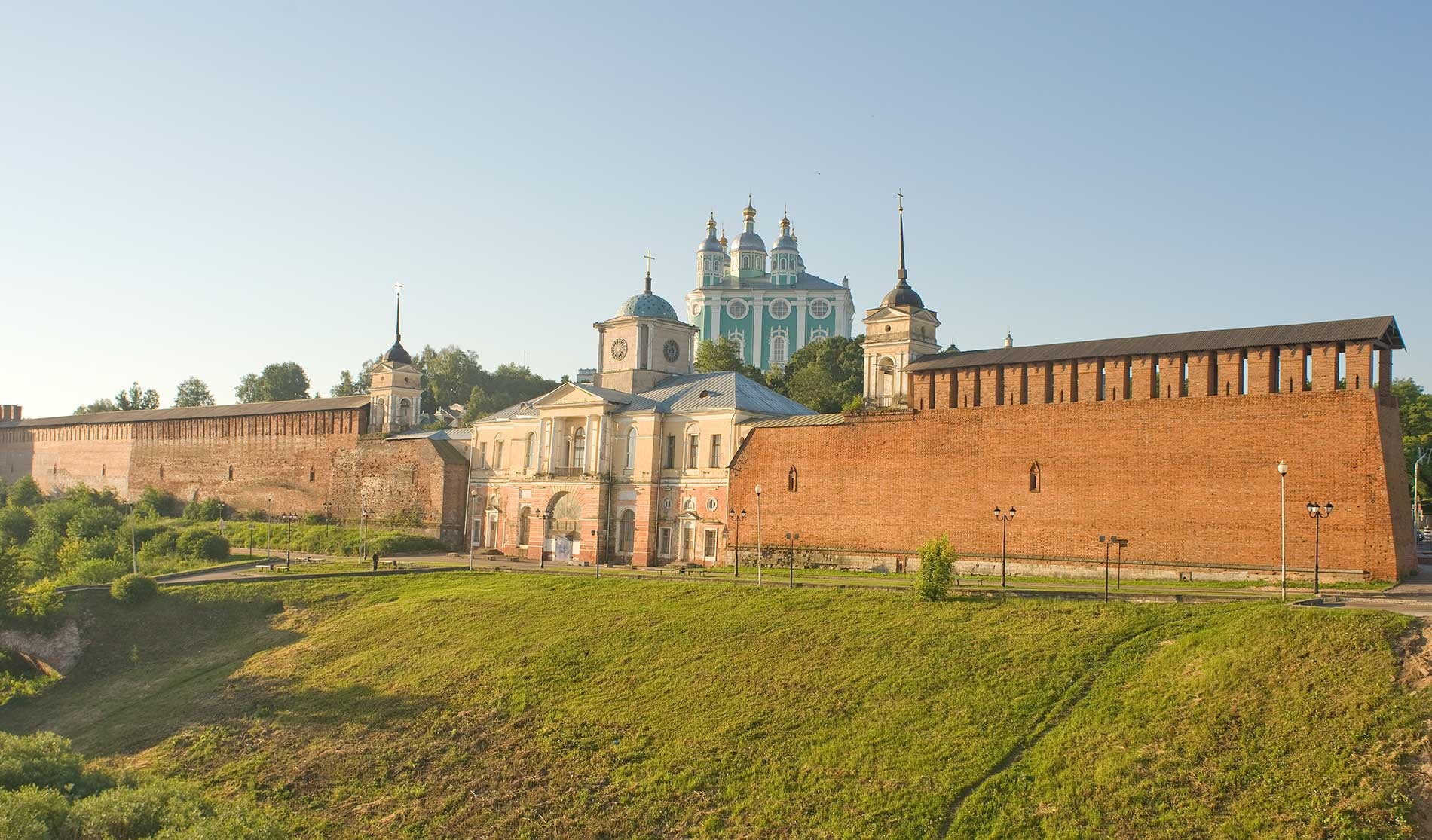
Smolensk citadel. North wall and Gate Church of the Hodegetria Icon of the Virgin. Northwest view from Central Bridge over Dnieper River. July 1, 2014
At the beginning of the 20th century, the Russian chemist and photographer Sergei Prokudin-Gorsky developed a complex process for color photography (see box text below). Inspired to use this new method to record the diversity of the Russian Empire, he undertook numerous journeys, one of which involved photographing sites linked to the centenary of Napoleon’s 1812 campaign against Russia .

Smolensk. View north from Dormition Cathedral bell tower. North wall and Dnieper Gate with Gate Church of the Hodegetria Icon. Beyond the two bridges across the Dnieper River is the Church of St. Nicholas. Summer 1912
Of special note is Prokudin-Gorsky’s work during the summer of 1911 in the city of Smolensk, site of a titanic struggle between Napoleon’s main forces and a Russian army commanded by Michael Barclay de Tolly. Prokudin-Gorsky was especially taken by the city’s grandiose fortress, whose walls and towers he photographed in detail. I photographed those walls a century later, in 2006 and 2014.
Contemporary Smolensk is a pleasant provincial capital (population around 325,000) graced with parks and lush greenery. Yet this placid appearance belies one of the most turbulent histories in European Russia. Its strategic position on major north-south and east-west routes has been both a blessing and a curse. From the 16th century to the 20th, the city experienced several clashes with forces from the west .
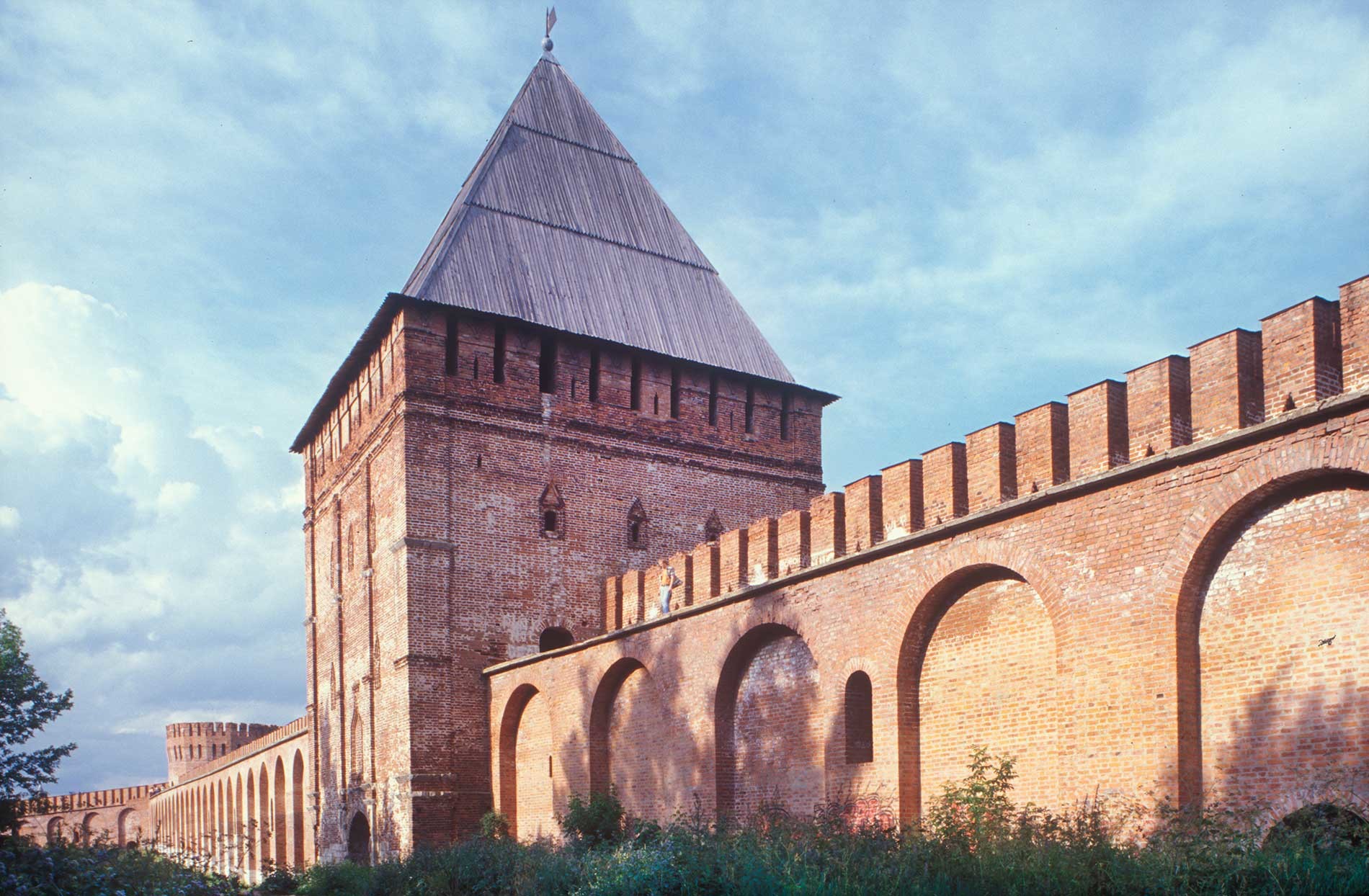
Smolensk citadel. East fortress wall with Avraamy Tower. West façade. Left background: Eagle (Oryol) Tower. July 15, 2006
Smolensk is among the oldest historic sites in Russia. First mentioned in medieval chronicles under the year 862, the early settlement was a center of the Krivichi, an eastern Slavic tribe. Smolensk’s location on the upper Dnieper River placed it on the lucrative trading route between the Baltic and the Black Seas, from “the Varangians to the Greeks.” By the late 9th century, the town had been brought into the orbit of Kiev, center of the Varangian princes of the Riurikovich dynasty on the middle Dnieper River.
With the conversion of Kiev's Grand Prince Vladimir to Orthodox Christianity in 988, Byzantine forms in architecture and art came to the Dnieper River basin. In the 1050s, Smolensk emerged as a subordinate principality that eventually came to rival the power of Kiev itself. To this day, Smolensk has some of the oldest churches in Russia .
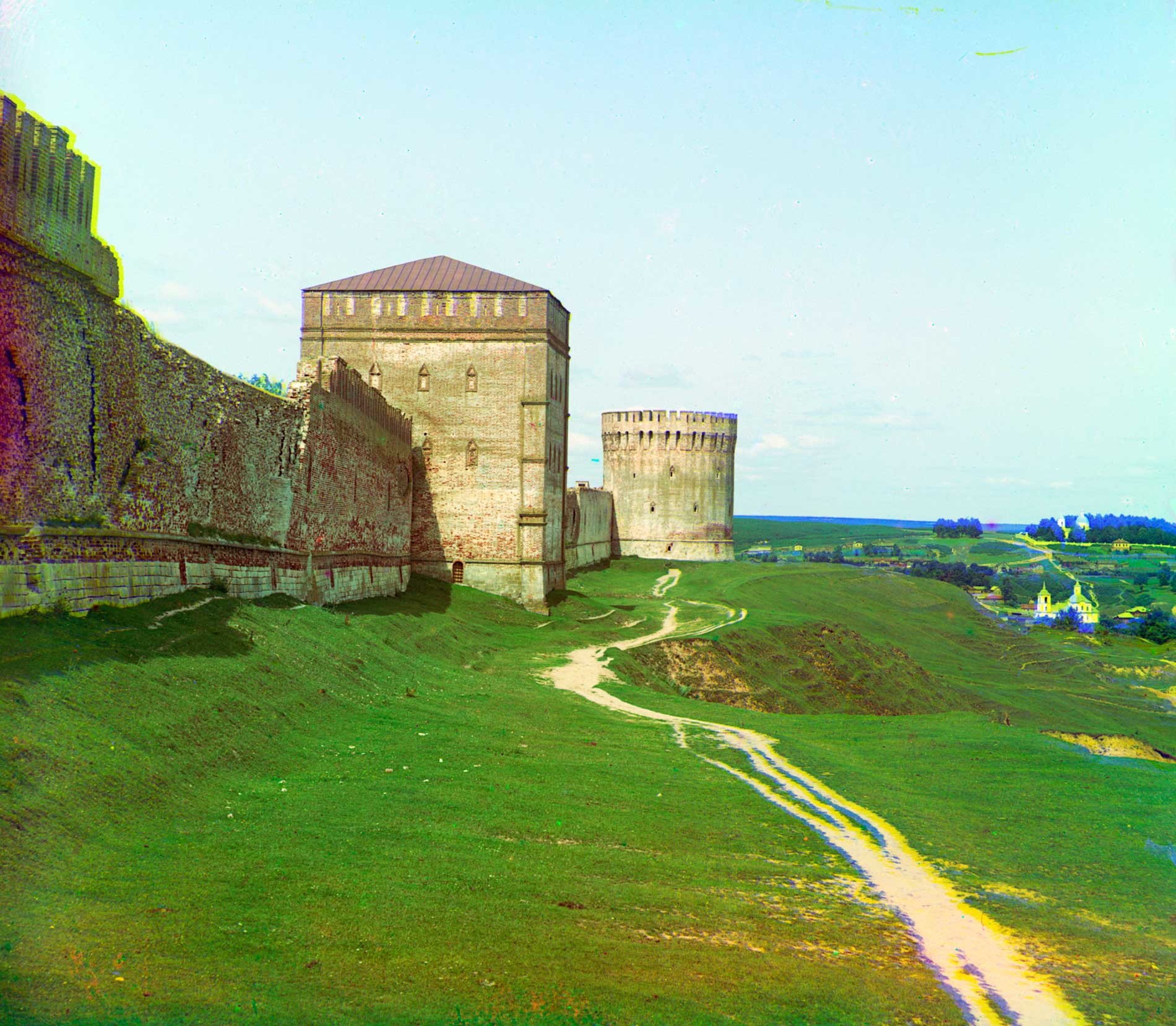
Smolensk citadel. East wall with Avraamy and Eagle (Oryol) Towers. East façade. Summer 1912
Smolensk was spared the devastation of the Mongol invasion that began in the winter of 1237-38. (Kiev, in contrast, was largely destroyed in 1240.), For the next four centuries, control over Smolensk alternated between the Grand Duchy of Lithuania, Poland and Moscow. The capture of Smolensk in 1514 by Basil III of Muscovy is considered a major event in Russian history.
A project of monumental scale
The strategic importance of Smolensk was reaffirmed by Tsar Boris Godunov (1551-1605), who saw it as a bulwark against Poland and undertook a fundamental rebuilding of the city walls between 1595 and 1602. The fortress was one of the largest Russian construction projects before the reign of Peter the Great. It had 38 towers along walls more than 4 miles long. In contrast, the walls of the Moscow Kremlin stretch less than 1.5 miles .
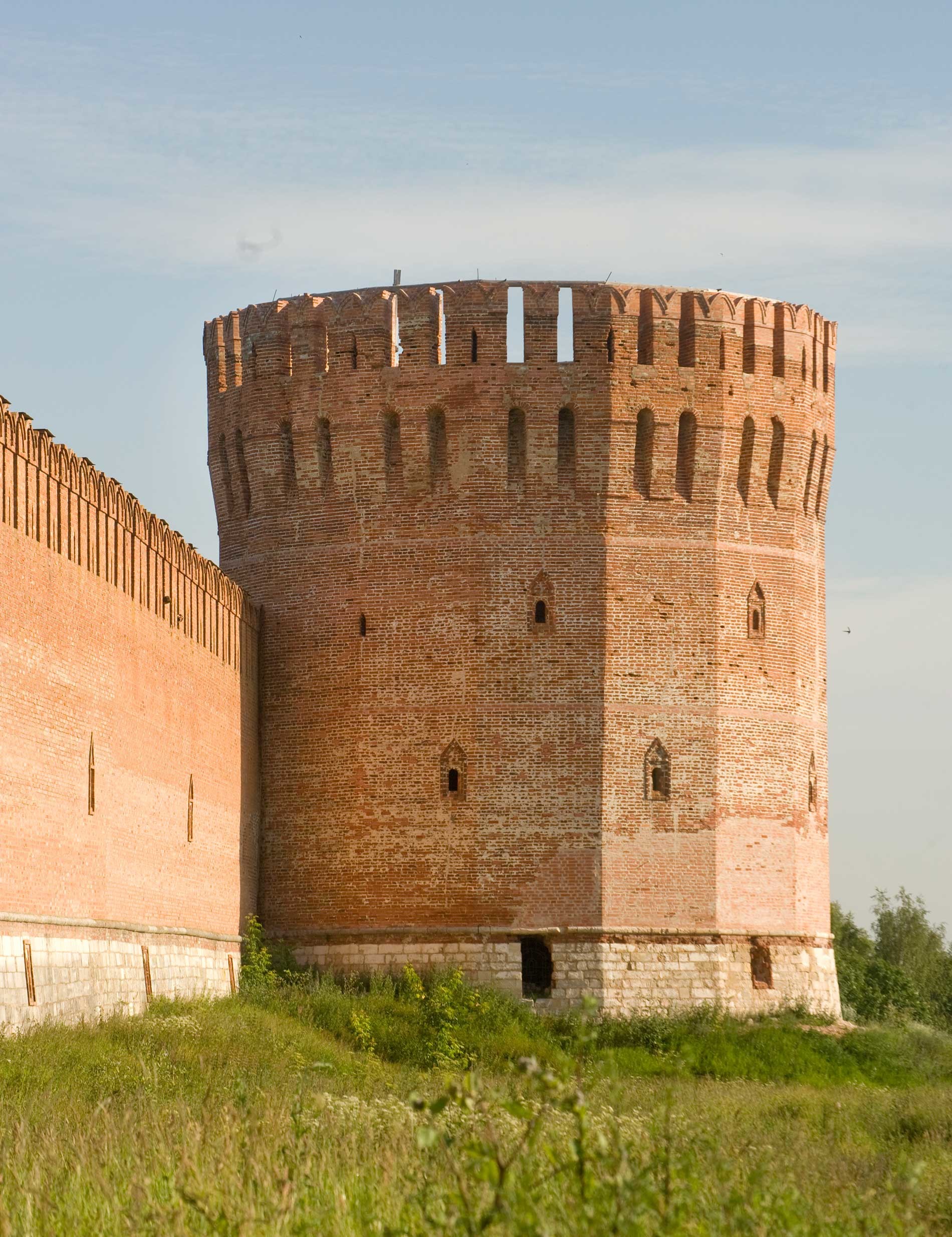
Smolensk citadel. East wall with Eagle Tower. East façade. July 1, 2014
Construction of the citadel, supervised by the engineer Fyodor Kon, required a vast mobilization of resources and compulsory labor from a large area under Muscovy’s control, including monastery and private brickyards enlisted in state service. During this period, masonry construction not connected with state service was prohibited on pain of death.
The production of the 100 million bricks needed for the Smolensk walls, and the great quantity of limestone blocks used for their base, in addition to lime, iron, and other components, could only have occurred with the standardization of building materials, particularly brick sizes. This production and the large labor force were organized under a centralized administrative system expanded under Godunov's able guidance. One of the main components of that system was the Office of Masonry Work ( Kamennyi prikaz ) that had been created in 1584 and used by Godunov to encourage masonry construction for individual as well as state projects .
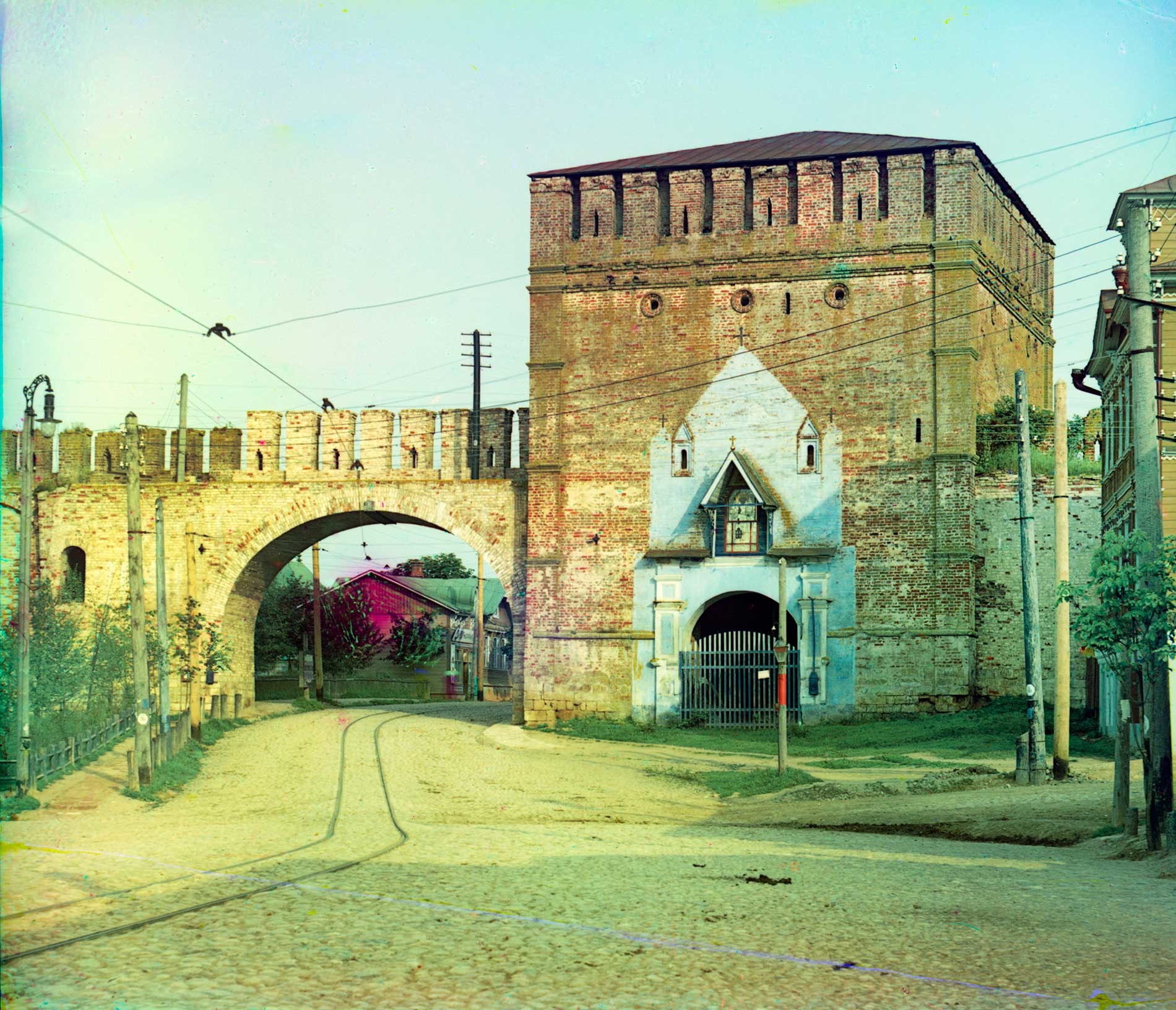
Smolensk citadel. St Nicholas Gate and Tower, with tram line. Summer 1912
The long walls had interior passageways and were crowned with crenellation to protect firing positions of the defenders. Many of the towers were square, but especially important points were dominated by massive polygonal towers such as the Eagle (Oryol) Tower on the south wall. Both Prokudin-Gorsky and I gave special attention to this tower.
Despite these forbidding walls, Smolensk was lost again to the Poles during Russia's dynastic crisis known as the Time of Troubles. From the time of Godunov's death in 1605 until the end of the 1610s, Russia was wracked by foreign invasion. In June 1611, Smolensk fell to the Poles despite the citadel’s heroic resistance in a 20-month siege. An attempt to retake Smolensk during the Russo-Polish War of 1632-34 (also known as the Smolensk War) failed ignominiously .
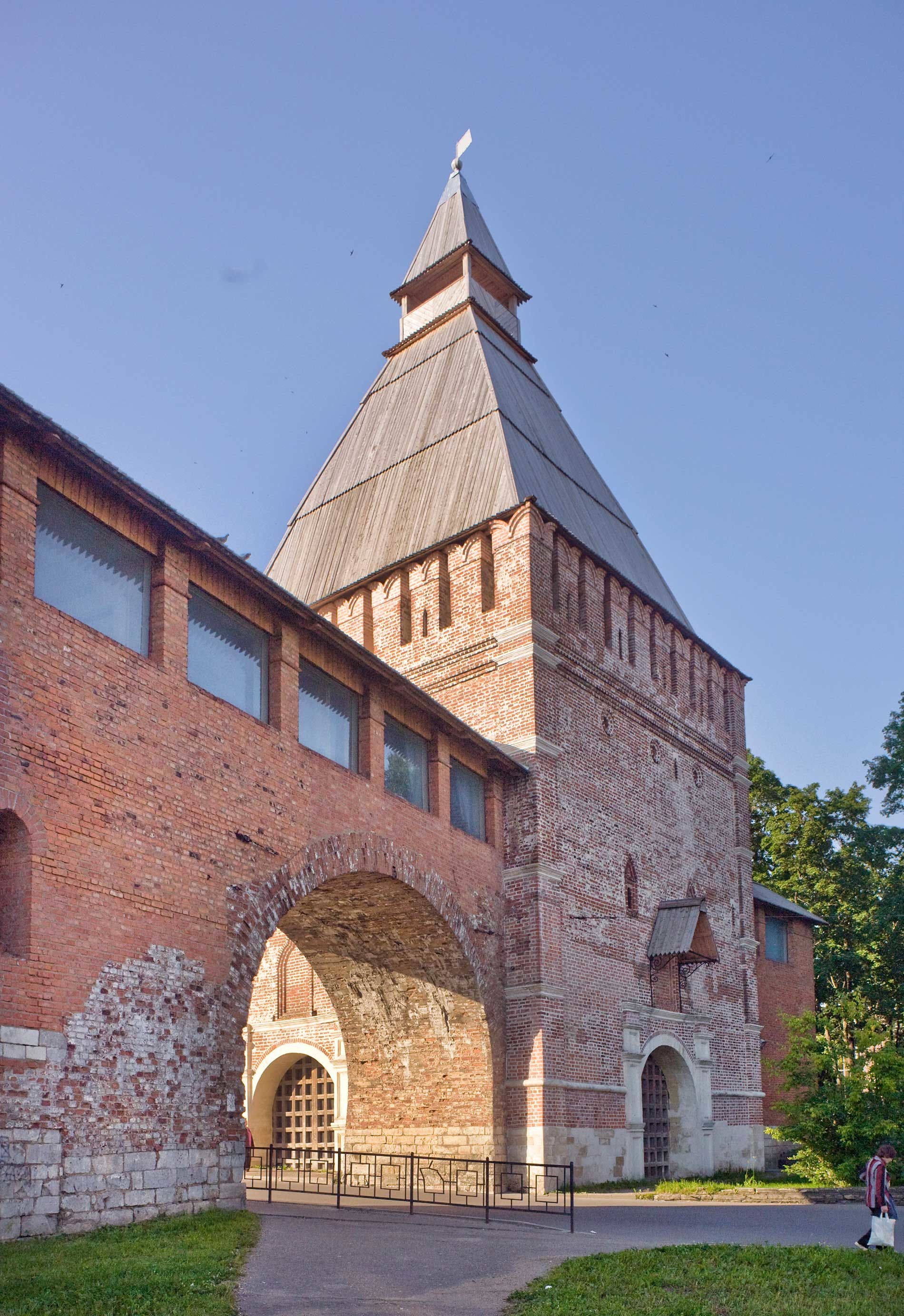
Smolensk citadel. St Nicholas Gate and Tower. July 1, 2014
Smolensk did not return to the Muscovite fold until a successful campaign in 1654. With the Andrusovo Truce of 1667, Moscow's possession was formally acknowledged by Poland and confirmed again by the Treaty of Eternal Peace between the two countries in 1686.
A century of chaos
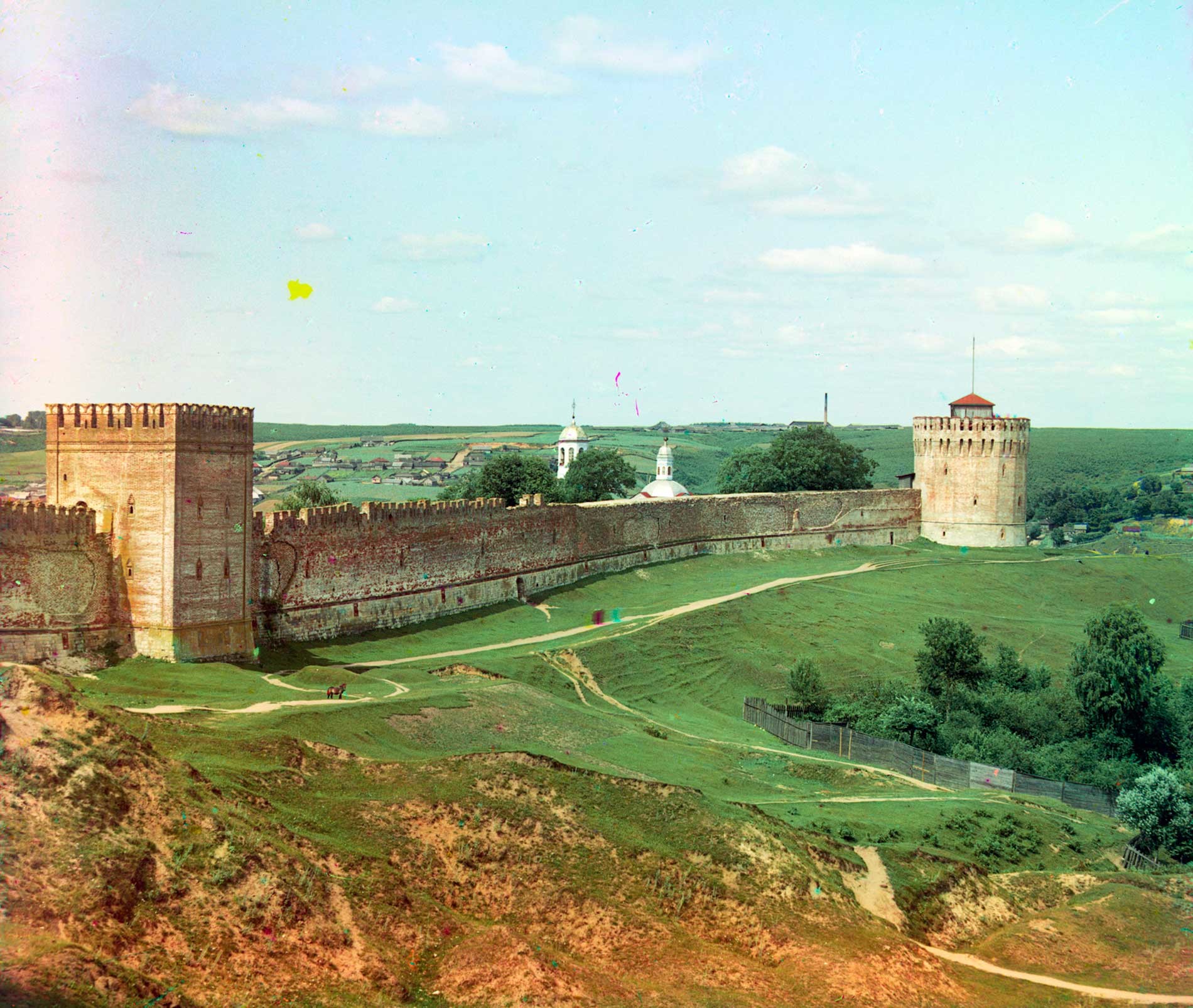
Smolensk citadel. East wall with Veselukha and Pozdniakov Towers. East façade. Summer 1912
The city's next military cataclysm occurred in mid-August 1812, when one of the major battles of the Napoleonic invasion was fought at Smolensk. Described in compelling detail by Leo Tolstoy in War and Peace , the Smolensk battle allowed the Russian army to retreat in orderly fashion but at catastrophic loss to the burned city. Only churches and most of the fortress walls remained relatively intact.
An important railroad hub at the beginning of the 20th century, Smolensk endured the chaos of World War I and the Russian Civil War. During the 1930s, when medieval fortifications in other cities were dismantled for building material, the surviving segments of the Smolensk citadel were largely preserved .
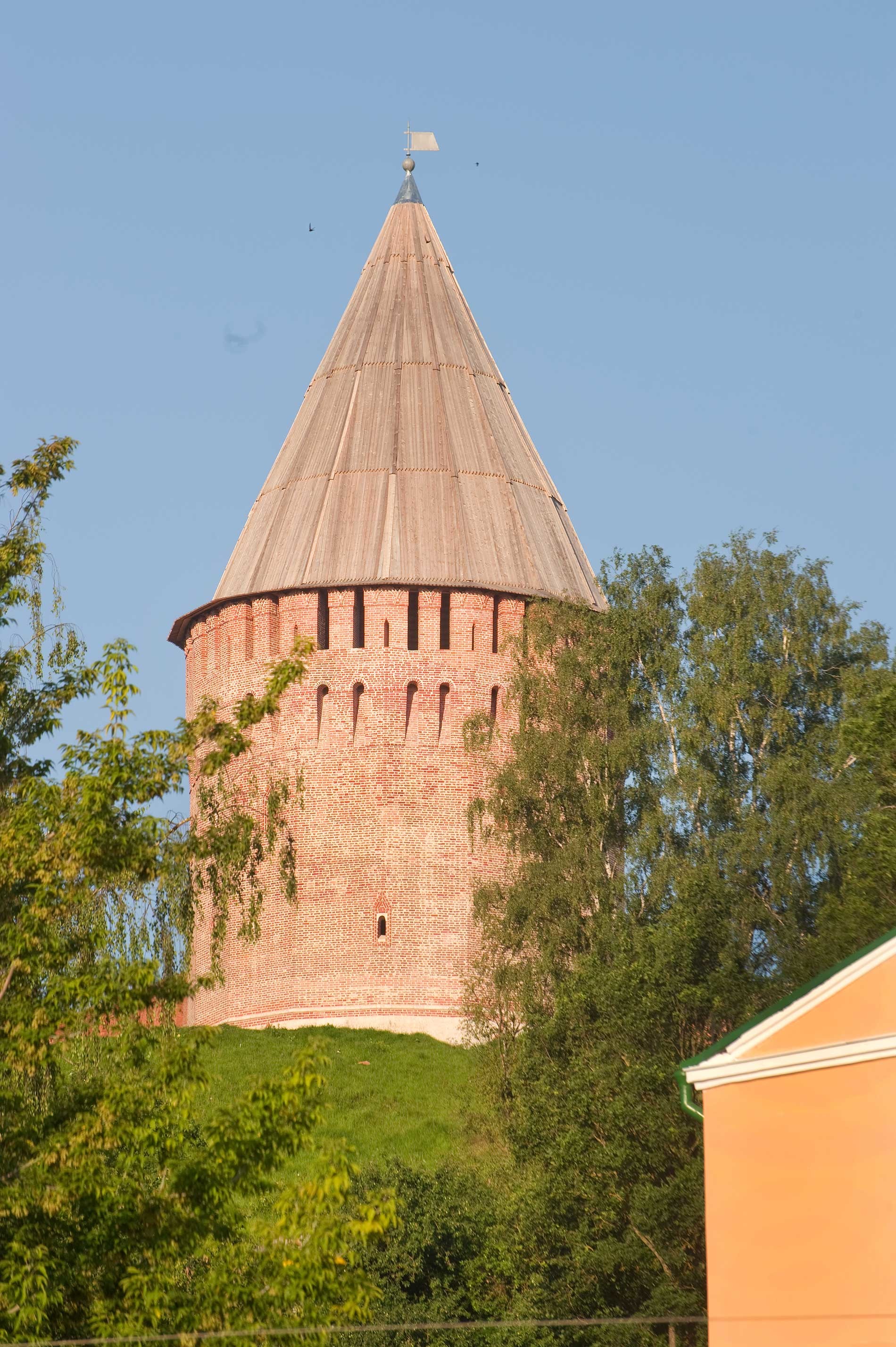
Smolensk citadel, northeast corner. Veselukha Tower, northeast view. July 1, 2014
The city’s greatest trial came with the German invasion of the Soviet Union on June 22, 1941. The Battle of Smolensk in late summer 1941 resulted in one of the worst Soviet losses, but the desperate struggles in that area gave the Red Army essential time to form defensive positions in front of Moscow during the following months.
Smolensk was liberated by the Red Army in late September 1943, but the town had suffered enormous material and human losses. Fortunately, the bulk of the fortress walls remained. In the decades since the war, much of the historic city has undergone extensive renovation. Collapsed portions of the north, east and south ranges have been rebuilt with their crenellation, and most of the towers now have steep wooden caps .
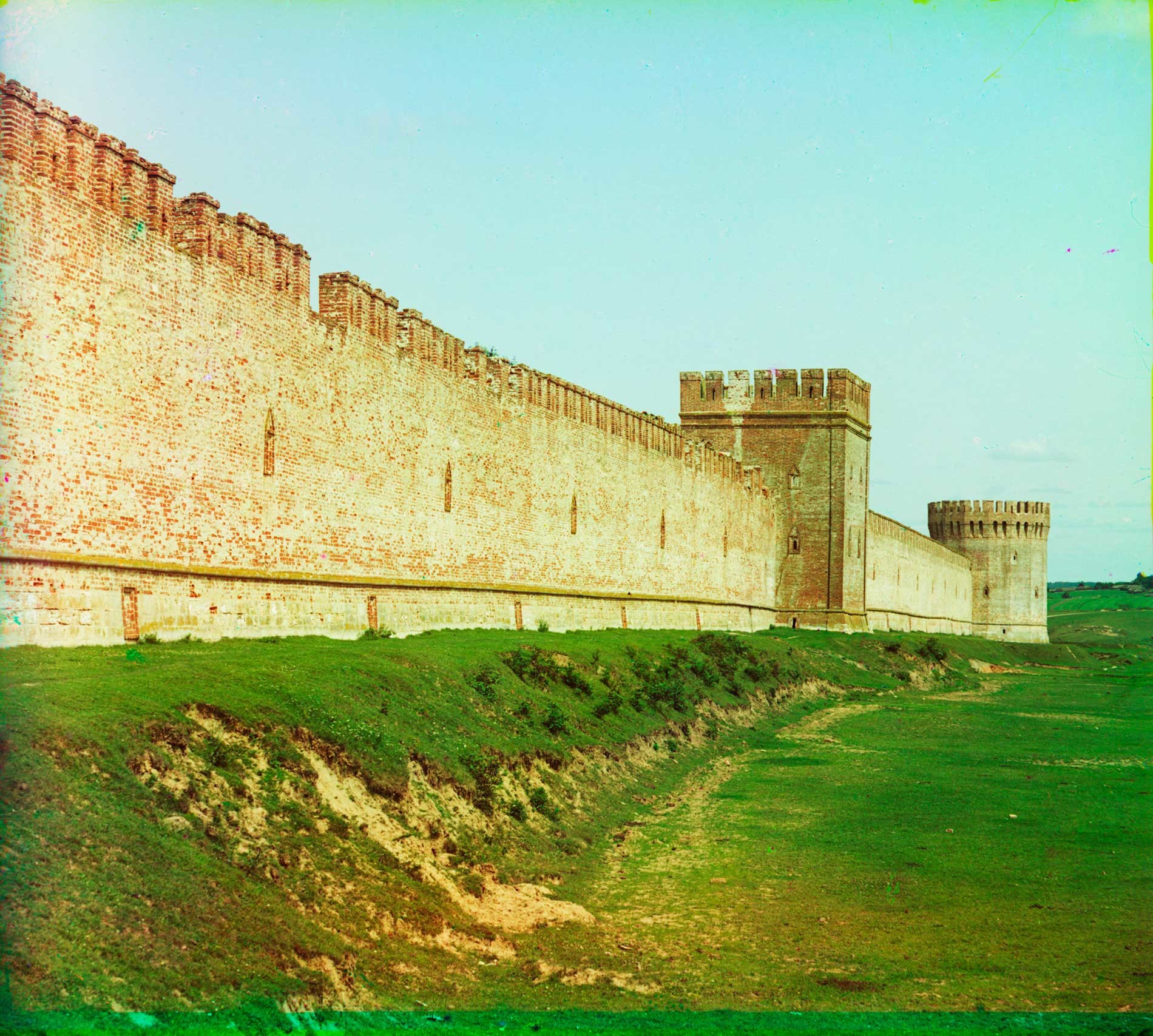
Smolensk citadel. Southeast wall with Voronin and Altar Towers. Summer 1912
Particularly impressive is the north wall (see pic. 1) along the Dnieper River, with the grand Dormition Cathedral rising on a hill above. The walls are now surrounded by parks, meadows and groves that create an attractive natural zone within easy reach of central city. After the turbulence of the 20th century, Prokudin-Gorsky’s photographs have profound value in documenting a citadel that is among Russia’s greatest monuments .
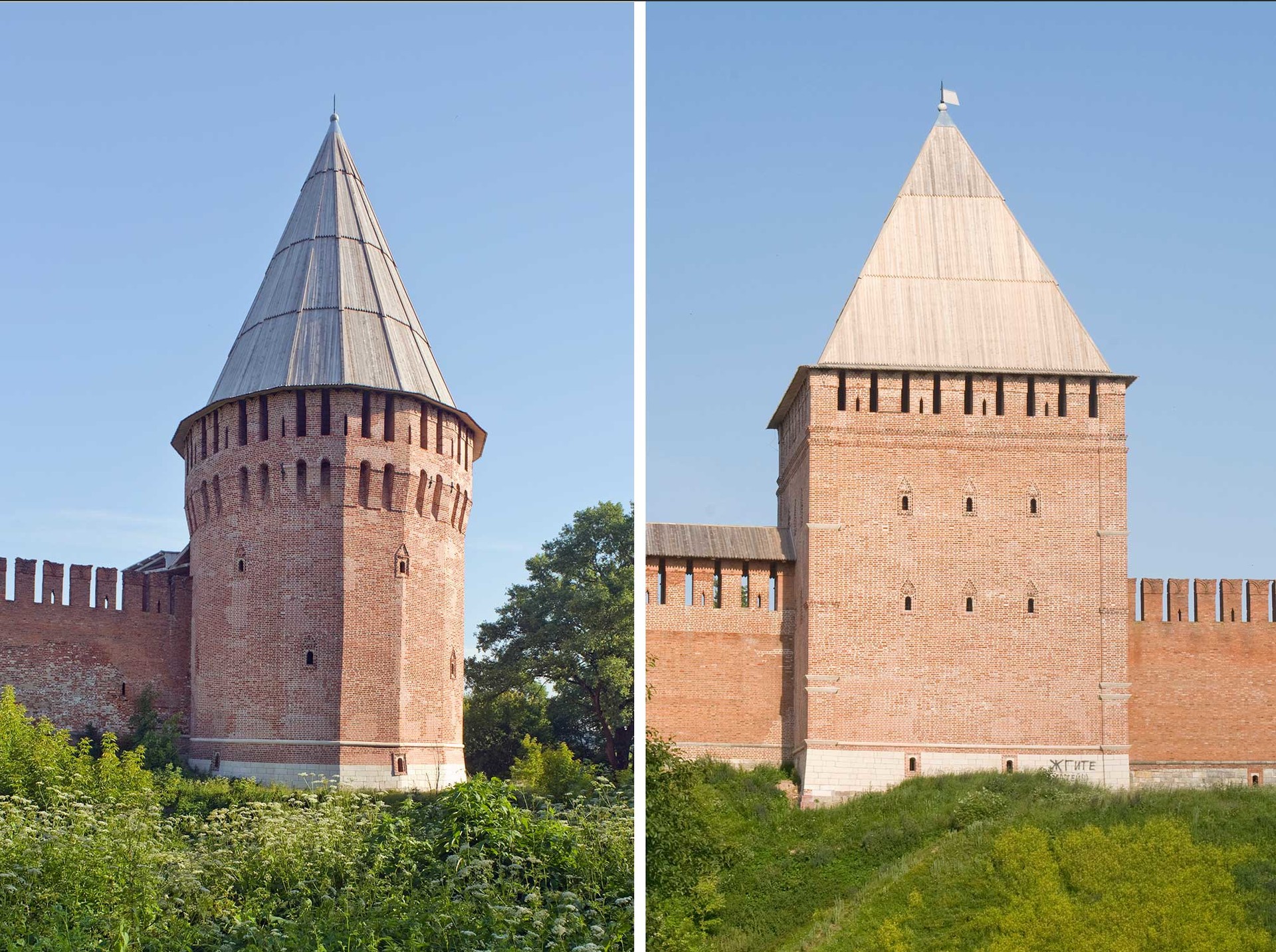
L: Smolensk citadel. Southeast corner with Altar (Belukha) Tower. R: Smolensk citadel. East wall with Avraamy Tower. East façade. July 1, 2014
In the early 20th century the Russian photographer Sergei Prokudin-Gorsky devised a complex process for color photography. Between 1903 and 1916 he traveled through the Russian Empire and took over 2,000 photographs with the process, which involved three exposures on a glass plate. In August 1918, he left Russia and ultimately resettled in France with a large part of his collection of glass negatives. After his death in Paris in 1944, his heirs sold the collection to the Library of Congress. In the early 21st century the Library digitized the Prokudin-Gorsky Collection and made it freely available to the global public. A number of Russian websites now have versions of the collection. In 1986 the architectural historian and photographer William Brumfield organized the first exhibit of Prokudin-Gorsky photographs at the Library of Congress. Over a period of work in Russia beginning in 1970, Brumfield has photographed most of the sites visited by Prokudin-Gorsky. This series of articles will juxtapose Prokudin-Gorsky’s views of architectural monuments with photographs taken by Brumfield decades later.
If using any of Russia Beyond's content, partly or in full, always provide an active hyperlink to the original material.
to our newsletter!
Get the week's best stories straight to your inbox
- Dubosekovo: Monument to a desperate struggle
- The vanishing treasures of the Russian North: The village of Paltoga
- William Brumfield: The American who made Russia’s architectural heritage famous abroad
This website uses cookies. Click here to find out more.
Please enter at least 3 characters
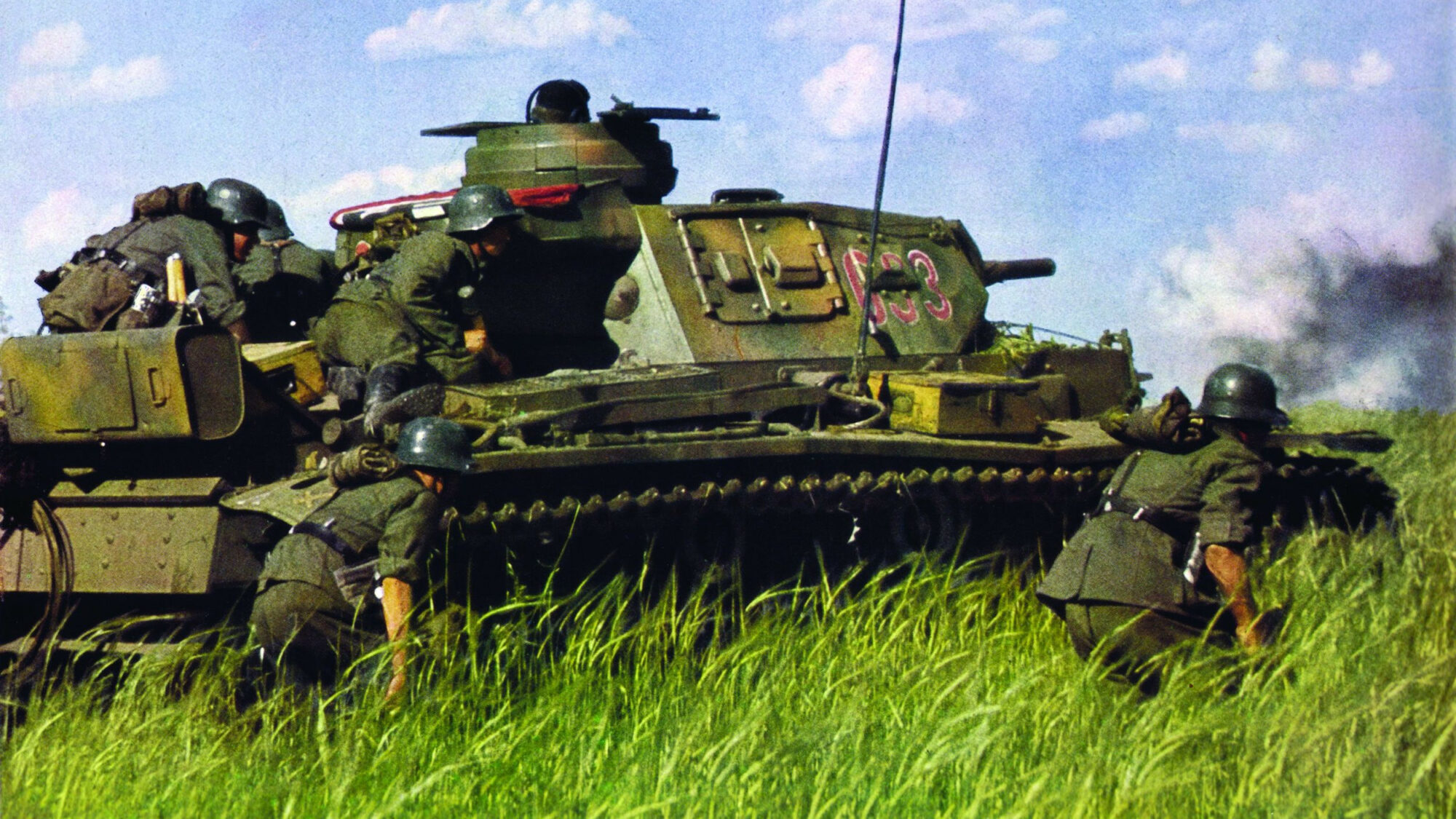
Operation Barbarossa: Holding the Line at Smolensk
In Smolensk during the summer of 1941, the Soviet Red Army attempted to slow the juggernaut of Nazi Operation Barbarossa.
This article appears in: January 2009
By Victor Kamenir
After crushing the first-line Soviet armies in brutal three-week cauldron battles at the border, the steamroller of German Army Group Center continued deeper into Soviet territory during the opening days of Operation Barbarossa, the invasion of the Soviet Union, which began on June 22, 1941.
The twin armored spearheads of Army Group Center were Panzer Group 2 under the command of General Heinz Guderian and Panzer Group 3 under extremely capable tank general Hermann Hoth. Their coordinated offensive on July 10, 1941, unleashed the Battle of Smolensk, a bloody struggle around the ancient Russian city that was to last two long months.
The Smolensk Gate: Land Bridge to Moscow
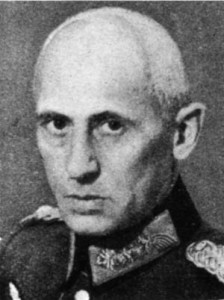
The city of Smolensk, long famous for its multitude of churches, occupied a strategically valuable “land bridge” on the way to Moscow. Known as the “Smolensk Gates” in Russia, the 45-mile wide neck of land between the headwaters of the Dvina and Dniepr Rivers was the traditional invasion route from central Europe into the heart of Russia. This road had been taken in the 17th century by the Polish Army, resulting in the capture of Moscow. In 1812, Napoleon fought a battle at Smolensk, burning the city to the ground.
Now, this region of fertile agricultural land was once again the stage for a titanic struggle. Still reeling from its earlier unexpected defeats, the Soviet high command hurriedly deployed a string of armies to protect this vital sector of the front. It was imperative to hold Smolensk at all costs, buying the Soviet leadership time to mobilize and deploy new armies for the defense of Moscow.
To stem the tide of disasters, Soviet Premier Josef Stalin instituted draconian measures. On June 30, General Dmitriy M. Pavlov, whose Western Army Front was crushed by Field Marshal Fedor von Bock’s Army Group Center, was recalled to Moscow. Served up by Stalin as a convenient senior scapegoat for the series of disastrous defeats, Pavlov was relieved of command, court-martialed along with several of his senior deputies, and executed, according to various sources, sometime between July and September 1941.
In his stead, on July 2, Stalin dispatched the top Red Army commander, Marshal Semyon K. Timoshenko, to take charge of the Western Front. Timoshenko’s reconstituted Western Front was created from second-echelon armies belonging to reserves of the high command. Spread out along almost 400 miles of front, from Idritsa in the north to Rechitsa in the south, were the Twenty-Second, Twentieth, Thirteenth, and Twenty-First Armies. Survivors of the Fourth Army, which had conducted a fighting retreat from the border, were being rallied and reorganized behind the Thirteenth Army in the area of Krichev.
Another two armies allocated to Timoshenko’s command, the Sixteenth and Nineteenth, were moving up from the Ukraine by train and were disembarking at various railroad stations around Smolensk just as the Germans launched their offensive. However, the move from the Ukraine was a difficult one, conducted in a chaotic atmosphere of poor coordination, gigantic traffic snarls at railroad stations, and punishing German air attacks. As a result, many trainloads of troops and equipment arrived in the wrong locations, some rerouted far to the east owing to damaged railroad tracks. Some units disembarked without their leadership and equipment, and some headquarters arrived without troops to command.
Conflicting Strategies in the German Camp
Both sides were racing against the clock. The Soviet command was rushing forward newly created units as soon as they were mobilized, very often practically untrained and poorly armed and equipped. Lacking reserves and having an extensive front to cover, the Soviet armies were deployed in one echelon, without any significant defenses in depth. Most Soviet rifle divisions held front lines of up to 15 miles, more than double what was called for in prewar planning.
The majority of Timoshenko’s forward rifle divisions were desperately short of specialized equipment such as radio and telephone sets, antitank artillery, transportation, and rear support services units. The drubbing that the Red Air Force received in the opening stages of the campaign and the lack of sufficient air defense artillery allowed the Luftwaffe to operate above the battlefield with virtual impunity. Most of the Red Army’s mechanized assets were destroyed in earlier fighting, and tanks were in short supply to contain breakthroughs or to follow up counterattacks.
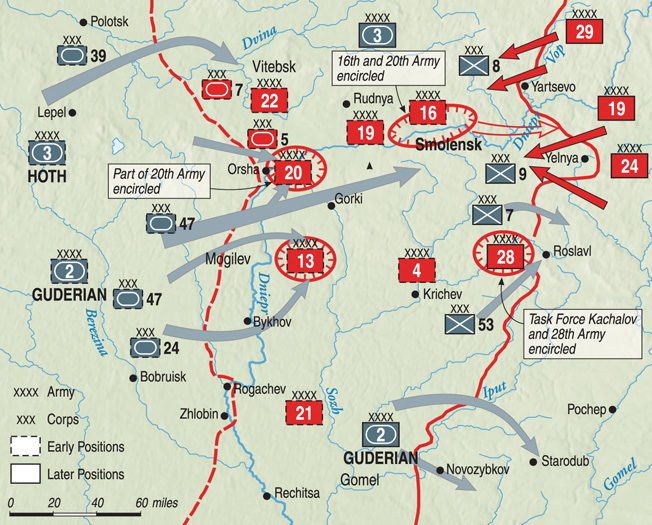
At the same time, a struggle over the character of ongoing operations was taking place within the German high command. Nazi dictator Adolf Hitler was preoccupied with the idea of not allowing the surrounded Red Army forces close to the border in the Byelostok and Minsk pockets to escape. He was demanding that the hard-charging panzer generals like Guderian and Hoth slow down, allowing infantry units to catch up and form a tight double ring around the surrounded Soviet troops. Further, during the first week of July Hitler began talking about halting the eastward advance once the vicinity of Smolensk had been reached and turning the panzers of Army Group Center north toward Leningrad and south into the Ukraine.
Another faction was strongly advocating continuing the rapid push to Moscow. Colonel General Franz Halder, chief of the German General Staff, while overtly paying lip service to Hitler’s plans, tacitly encouraged carrying on the offensive. In his war diary, Halder wrote on June 29: “Let us hope that commanding generals of corps and armies will do the right thing even without express order, which we are not allowed to issue because of the Führer’s instructions to Army High Command.”
Guderian, in his turn, clearly saw that speed was of the essence: “It would be some 14 days before our infantry could arrive on the scene. By that time the Russian defenses would be considerably stronger. Whether the infantry would then be able to smash a well-organized river defensive line so that mobile warfare might once again be possible seemed doubtful.… I was so convinced of the vital importance and of the feasibility of the task assigned me, and at the same time so sure of the proved ability and attacking strength of my panzer corps, that I ordered an immediate attack across the Dniepr and a continuation of the advance toward Smolensk.” General Hoth was also in support of continuing the drive on Smolensk.
Stretched Supply Lines
Planning his attack against Smolensk, Field Marshal Gunther von Kluge, in overall command of both panzer groups, intended to fracture the Soviet Western Front and annihilate the bulk of its forces in familiar cauldron battles. The northern sector of von Kluge’s area of operations was characterized by extensive marshlands, small rivers, and wooded terrain not favorable for panzer operations; therefore, the emphasis would be toward the south, where more open terrain was well suited for far-ranging panzer maneuvers. The epicenter of the German attack was concentrated against the area of the Vitebsk–Orsha–Mogilev line.
The capture of Smolensk called for a typical pincer movement, skirting the city from north and south and linking up east of it, in the Yartsevo–Yelnya area. The XXXIX Motorized Corps, belonging to Hoth’s Panzer Group 3, was to strike from Vitebsk to Demidov and, from there to Yartsevo. The XLVII Motorized Corps from Guderian’s Panzer Group 2 was to attack from Tolochin, where Napoleon had his headquarters in 1812, to Orsha and then to Yelnya. Advancing on the right flank of Guderian’s group, his XLVI and XXIV Motorized Corps were to form a smaller pocket around Mogilev and then push southeast to Roslaval.
The weakness of the German plans lay in the fact that supply lines were getting seriously overstretched and the supporting infantry armies marching on foot, the Ninth Field Army for Hoth and Second Field Army for Guderian, were over 60 miles behind their fast-moving mechanized brethren. This would soon play a significant role, allowing many of the Soviet units bypassed by German motorized corps to slip away to the east.
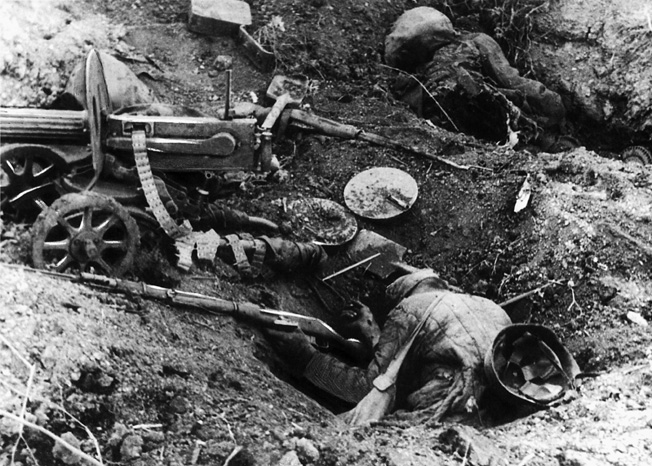
Controlling the Soviet Panic
German plans were slightly delayed when on July 6 Timoshenko launched a determined attack against Panzer Group 3 from the Vitebsk area toward Lepel, utilizing the V and VII Mechanized Corps. However, the poorly coordinated Soviet attack went in with virtually no reconnaissance and ran into prepared German antitank positions. During the grinding three-day battle, the two Red Army mechanized corps were savaged in large part by a combination of vicious Luftwaffe air attacks and the direct fire of antitank artillery. Counterattacking the reeling Soviet formations on July 9, Hoth’s 7th and 18th Panzer Divisions punched a hole between the Soviet Twentieth and Twenty-Second Armies and captured Vitbesk.

Timoshenko, lacking ready reserves to plug the gap between the two armies, was forced to commit the closest units of the 19th Army, without their having a chance to reorganize after a difficult move from the Ukraine. On July 10, Lt. Gen. Ivan Konev, commander of the Nineteenth Army, counterattacked with two available divisions, the 220th Motorized Rifle and 162nd Rifle. The 220th, despite being composed largely of barely trained recruits, conducted itself well and even fought to the east side of Vitebsk. However, it sustained prohibitive losses on its first day of combat, with one of its regimental commanders killed.
The 162nd Rifle Division fared much worse, initially making some progress, but falling back very soon. Maj. Gen. Aleksandr V. Gorbatov, deputy commander of the XXV Rifle Corps, approached Vitebsk and encountered groups of Red Army soldiers streaming eastward in disorder. Gorbatov and his staff officers were able to halt groups of retreating men and begin digging astride the Vitebsk–Smolensk road. Leaving behind several of his officers to continue rounding up and reorganizing stragglers, General Gorbatov rushed to the original positions of the retreating 501st Rifle Regiment, less than two miles to the west. To his horror, Gorbatov found the positions completely abandoned, save for three men. One of them was the regimental commander, a Colonel Kostevich, accompanied by his chief of staff and a corporal serving as a radio operator.
Gorbatov later wrote, “When I asked the regimental commander: ‘How did you manage to get to this situation?’—he, helplessly motioning with his arms, replied: ‘I understand the gravity of what happened, but could not do anything; therefore, we decided to die here, but not to retreat without orders.’ There were two Orders of the Red Banner on his chest. But, recently called up from reserve, he spent many years out of the army and, apparently, completely lost leadership skills. True, he was quite capable of dying without abandoning his post. But who would benefit from that? It was embarrassing to look at his pathetic appearance.
While realizing that returning the regiment to its previous positions was out of the question, I invited the officers to come with me, loaded them up in [my] car and took [them] to the regiment. I pointed out to Kostevich a position for his observation post, advised him how to best deploy his battalions and fire support assets … In the woods, to the right of the highway, I found the corps’ artillery regiment and discovered that its guns did not have prepared firing positions and commanders of the regiment and [its battalions] did not have observation posts.”
Unfortunately, the panic was beginning to spread through many units of the Twentieth and Twenty-Second Armies. Lt. Gen. Konev discovered complete chaos near Rudnya, a small town between Vitebsk and Smolensk: “A disorganized stream was moving toward us—vehicles, wagons, horses, columns of refugees with many soldiers among them. Everyone was in a hurry toward Smolensk. It was absolutely impossible for us to drive to Vitebsk. The road was completely choked. I decided to [use my] staff officers to put the things on the road in order, gave instructions to stop all military personnel, form up infantry units, separate artillerymen, tankers and send everybody back to Vitebsk. To my surprise, even tanks were moving from Vitebsk to Rudnya—several heavy KVs and several T-26s. Especially strange was to see the retreating new tanks. Three KV tanks were moving to Rudnya, allegedly for repairs. Literally threatening them with guns, sticking revolvers into drivers’ hatches, we stopped these tanks, which, by the way, turned out to be operational; we took them under control. In this manner we managed to collect by evening almost a battalion of infantry, a battery of 85mm air defense guns, and a battery of 122mm guns.”
Orsha and Mogilev Encircled
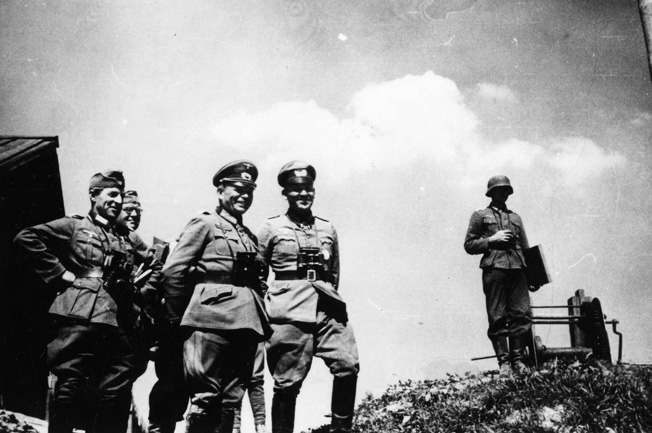
Despite the best efforts of senior Soviet officers, during the next several days, Hoth’s divisions steadily pushed the Nineteenth Army east and encircled the right flank of the Sixteenth and Twentieth Armies north and west of Smolensk. On the same day, Guderian’s XLVII Motorized Corps, skirting the city to the south, came close to linking up with the northern pincer and completely surrounding the two Soviet armies. The beleaguered Nineteenth Army and survivors of V and VII Mechanized Corps barely managed to hang on to one Dniepr River crossing near Solovyevo village, approximately 10 miles south of Yartsevo, holding open a lifeline to their comrades at Smolensk.
Launching his attack across the Dniepr River on July 10, General Guderian established several vital bridgeheads on the east bank, striking at the junction of the Soviet Twentieth and Thirteenth Armies south of Orsha and prying apart the flanks of both armies.
A bitter fight flared up for Orsha, defended by units from the Soviet Twentieth Army. Especially distinguishing themselves were the 73rd Rifle Division under Colonel A.I. Akimov and 1st Proletarian Motorized Rifle Division under Colonel Yakov G. Kreitzer. This latter division initially belonged to the VII Mechanized Corps but was diverted south prior to VII Corps’ ill-fated attack and was spared destruction along with its parent unit. The 1st Proletarian Division, stationed in one of Moscow’s suburbs, was the Red Army’s showpiece and experimental unit. It was constantly kept at near full strength and was usually given new equipment and tactics to test. Colonel Kreitzer served almost his entire career in this unit, progressing from platoon leader to division commander and, unlike many of his fellow officers, enjoying the complete trust and confidence of his men.
As a curious side note, many well-known Moscow athletes were sent to this division upon mobilization. In addition, Lieutenant Rueben Ibarruri, son of exiled Spanish Communist leader Dolores Ibarruri, served in this unit until being wounded in subsequent fighting.
On July 11, as Colonel Kreitzer was preparing his division for a counterattack the next day, he was seriously wounded in his right arm during an air attack and taken to the rear. The next day, before Kreitzer’s division had a chance to attack, its neighboring LXIX Rifle Corps was hit hard by combined German air and panzer attacks and withdrew, jeopardizing the flank of the Moscow division. Despite the best efforts of its defenders, Orsha was completely surrounded on July 14.
After holding the defenses of Orsha for several days, the units trapped within the small pocket, spearheaded by the 1st Proletarian Motorized Division, fought their way clear before the German ring had a chance to solidify. Unable to retreat east, survivors of the division, now numbering only 1,500 men plus some from the LXIX Rifle Corps, turned south and joined the defenders of Mogilev, also surrounded.
Mogilev, encircled since July 12, was held by parts of the Soviet Thirteenth Army, in particular the LXI Rifle Corps under Maj. Gen. F.A. Bakunin. Attempting to relieve pressure on Mogilev, the Twenty-First Army launched an attack on July 13 led by its LXIII Rifle Corps under Lt. Gen. Leonid G. Petrovskiy. In a spirited advance, Petrovskiy’s men crossed to the west side of the Dniepr River, recaptured Rogachev and Zhlobin, which had been lost on July 9, and continued moving to Bobruisk. The German command had to shift valuable reserves to slow the Soviet offensive. Even though much pressure was taken off Mogilev’s defenders, the LXI and LXIII Corps could not link up and Bakunin’s command remained trapped inside Mogilev.
On July 27, survivors of the LXI Rifle Corps and the 1st Proletarian Division fought their way out of the encirclement and linked up with the main Soviet forces. Not all the Red Army men were able to make it out of Mogilev. Some stragglers became stranded in the city when the last bridge was destroyed by their retreating comrades. Surrounded Soviet soldiers fought for another day before being hunted down among the ruins, killed or taken prisoner. Colonel Yakov Kreitzer soon rejoined his men, and the 1st Proletarian Division was rebuilt with new soldiers and proud traditions. Colonel Kreitzer himself survived the war and rose to high rank in the Red Army.
When Guderian struck at the junction of the Soviet Twentieth and Thirteenth Armies on July 10, his attack was so determined that it pushed the bulk of Lt. Gen. P.A. Kurochkin’s Twentieth Army to the northeast of Orsha and to the north side of the Dniepr River. While the panzers bypassed Smolensk on the way to Yartsevo, elements of the 29th Motorized Division broke into Smolensk from the south and began digging out the stubborn defenders block by block. The German attack was executed with such speed that Soviet commanders did not have a chance to organize proper defenses of the city.
Capturing Smolensk and Stalin’s Son
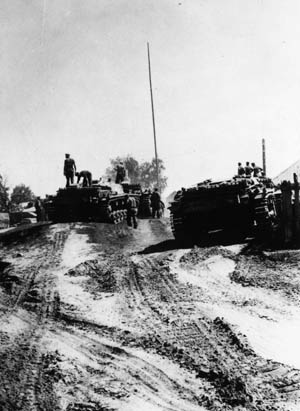
The city of Smolensk is divided roughly in half by the Dniepr River, which flows east to west in this area. By nightfall on July 15, the Germans were in possession of the southern part of the city. As the bulk of the city’s defenders, mainly from the Sixteenth Army, retreated to the north side of the river, the commander of Smolensk garrison, Colonel P.F. Malyshev, ordered the inter-city bridges blown up.
The commander of the Sixteenth Army, Lt. Gen. Mikhail F. Lukin, began frantically organizing defenses on the north side of the river. With the war less than four weeks old, Lukin had already distinguished himself as a skilled commander. When the war started, Lukin’s army was in the process of being transferred by train to the Ukraine from a Siberian military district. As his first trainloads began unloading at Shepetovka, Lukin, like Konev, received orders to divert his army north into Belarus, where the Soviet forces of the Western Front were being crushed.
However, an unexpected breakthrough by German Army Group South at Ostrog threatened Shepetovka, a vital railroad center and site of a major Red Army supply and ammunition depot. As the senior commander on the scene, Lukin hurriedly put together a scratch force consisting of parts of two of his divisions and whatever other units he could find. He held the line for several desperately needed days until a rifle corps relieved him.
Now, as Smolensk burned around him, Lukin ordered his men to occupy positions at the water’s edge to discourage German attempts to cross the river during the night and establish beachheads. Lukin’s attempts to shift his troops from the northern edge of the city to the river were hampered by having to navigate the city streets amid burning buildings and German shelling. It was too late. On the morning of July 16, the Germans renewed the attack, and even though Lukin’s men fought tenaciously the German 29th Motorized Division was in complete possession of Smolensk by that evening.
Also on this day, Senior Lieutenant Yakov Dzhugashvili, commander of an artillery battery in the VII Mechanized Corps, was captured east of Vitebsk. Yakov was Stalin’s son by his first wife, Ekaterina Svanidze, who died in 1907 from tuberculosis. Yakov and Stalin did not get along well, with Yakov often bearing the brunt of Stalin’s insults and angry tirades. Later in the war the Germans proposed to exchange Yakov for Field Marshal Freidrich Paulus, captured at Stalingrad in 1943. Stalin turned down the offer, allegedly stating: “I do not trade lieutenants for field marshals.” Shortly thereafter, Yakov committed suicide in a POW camp by charging the wire. He was shot dead by a German guard.
The Counterattack at Smolensk
Hearing of the loss of Smolensk, Stalin flew into a rage, accusing Marshal Timoshenko and his staff of cowardice and defeatist spirit. The specter of the fate of Col. Gen. Pavlov was fresh in Timoshenko’s mind.
Without giving them pause, on July 17 the Soviet Marshal ordered Lt. Gen. Konev and his Nineteenth Army to retake Smolensk. At the same time, orders were transmitted to the two armies in the Smolensk pocket to continue their attacks. While the Twentieth Army fought northwest of the city, Lukin’s Sixteenth Army attacked east toward the Nineteenth Army. As the fighting raged across Smolensk, the majority of the ancient city was turned to ruins. On July 19, Lukin’s men managed to capture a toehold in the northwest part of the city. In bitter house-to-house fighting amid the rubble of destroyed buildings, a precursor of things to come at Stalingrad, the Germans were completely pushed out of the northern part of Smolensk by the end of July 25.
In addition to Konev’s army, Timoshenko and the Soviet high command organized five task forces to take control of units that retreated to the line of the Dniepr and Vop Rivers, as well as some reserve units arriving at the front. After a short preparation, four of these combat groups, each numbering several infantry and tank divisions, were committed to the fight directly east of Smolensk, while another one, under the command of Lt. Gen. V.Y. Kachalov, formed around his Twenty-Eighth Army and operated farther south, west of Roslavl. A separate task force of three cavalry divisions was formed under Lt. Gen. Oka I. Ogorodnikov, a hero of the Russian Civil War, in order to conduct a deep raid into German rear areas.
The experiences of Maj. Gen. Konstantin K. Rokossovsky characterized the desperation with which the Soviets attempted to restore the situation at Smolensk. Arriving in Moscow on July 17 fresh from fighting in the Ukraine, Rokossovsky was placed in charge of one of the task forces, a group of two or three tank divisions and one rifle division. He was to proceed with all haste to take charge of the allocated formations in addition to being given permission to round up and take control of all units he encountered on the road from Moscow to Yartsevo.
However, he left the capital with only a handful of people: “The General Staff gave me two trucks mounting quad air defense machine guns with crews, a radio truck and a small group of officers,” he remembered. Several days later, his combat group absorbed the survivors of the VII Mechanized Corps, with the command element of the destroyed corps becoming Rokossovsky’s headquarters staff.
The newly created combat groups jumped off on July 23, and they immediately ran into determined German opposition with the furthest progress being roughly 12 miles. The intensity of the fighting is illustrated by the experience of the 101st Tank Division in Task Force Rokossovsky, which lost 140 of its roughly 170 tanks during the four days of fighting on July 18-21. Gorodovikov’s cavalry fought its way to the area of Bobruisk by July 24 at tremendous cost.
Characteristically, the Germans counterattacked. On July 29, the German panzers from two groups linked up at the Solovyevo crossing. They destroyed the pontoon bridge and captured the west side of the river. The Soviets doggedly fought on, however, and retained control of the eastern end of the river crossing, preventing the Germans from gaining a foothold on the east bank.
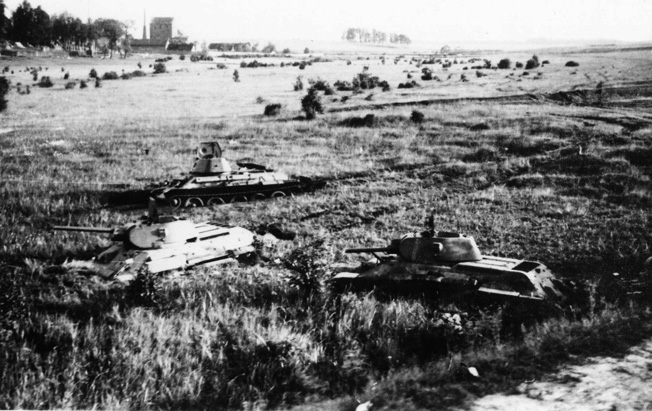
A Hasty Rout
Farther to the south, Kachalov’s task force, built around the bulk of his Twenty-Eighth Army, was almost completely surrounded on July 26 by several German formations, including the 2nd SS Division Das Reich and the Infantry Regiment Grossdeutschland. In a desperate attempt to fight clear of the encirclement, Lt. Gen. Kachalov was killed. Following on the heels of the retreating Russians, the Germans captured Roslavl on August 3.
The fight in the small area between Smolensk and Yartsevo turned into a slugfest, with both sides suffering horrendous casualties in the process. On July 30, after paying a high toll in men and equipment, Rokossovsky’s task force broke through to the two beleaguered armies at Smolensk. By this time, divisions of Sixteenth and Twentieth Armies were down to less than 2,000 men each. In addition to the Solovyevo crossing, Rokossovsky’s troops established another crossing farther north, near Golovino village, and the units from the 16th and 20th Armies began pouring through.
Instead of an organized Soviet withdrawal, the scene turned into a chaotic rout, with people desperate to escape literally storming the bridges. The first to escape were the rear support units, often abandoning valuable equipment and vehicles. Over the next several days, however, relative order was restored and the bulk of the survivors from the Sixteenth and Twentieth Armies crossed to the east bank of the Dniepr, abandoning the smoking ruins of Smolensk.
The retreat was accomplished under continuous German shelling and bombing. When the pontoon bridge at Golovino was destroyed, heavy equipment was routed to the Solovyevo crossing, while infantry and some horse-drawn artillery continued fording the Dniepr River, which was fortunately only two to three feet deep in this area.
Despite the majority of their men fighting bravely, the Soviet commanders had to constantly contend with breaks in morale. Rokossovsky later wrote, “To my great sorrow, about some things I do not have the right to remain silent; there were many instances of cowardice by the soldiers, panicking, desertion and self-mutilation to avoid having to fight. At first, the so-called ‘left-handers’ appeared, those who would shoot through the palm of their left hand or shoot off the thumb, or several fingers. When this came to light, the ‘right-handers’ appeared, doing similar things, but on the right hand. Sometimes mutilation was mutual: two men would shoot each other’s hands. A law was soon passed, allowing the use of the highest measure of punishment (the firing squad) for desertion, avoidance of battle, self-mutilation and insubordination in combat situations.”
The Germans Capture Yartsevo and Yelnya
As the fighting at Smolensk raged, the Soviets were making the best use of the time bought at such a high price. Two more defensive lines were established east of Smolensk on the road to Moscow, manned by four newly created armies, the Twenty-Fourth, Twenty-Ninth, Thirtieth, and Thirty-First, plus the Twenty-Eighth and Thirty-Second Armies united into the Reserve Front under General Georgy Zhukov.
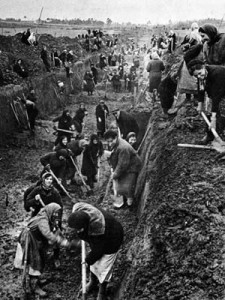
More than 300,000 civilians were put to work digging extensive earthworks, which consisted of tank traps, trenches, ditches, and other obstacles. Among those sent to work on fortifications was 18-year-old Moscow student Yevgeniy Bessonov. He recalled hard work under difficult conditions, often being strafed and bombed by German aircraft: “We worked 12 hours a day and, unaccustomed to physical labor, would become very exhausted. We would fall asleep as soon as we touched our ‘bed’ made from hay or straw, prepared mainly in barns. We dug antitank ditches, trenches along river banks, foxholes, and set up wire obstacles. In some instances we would repair railroad tracks after bombing and clear them of destroyed boxcars. But our main occupation was digging antitank ditches.”
Despite the Soviet propaganda claims about the widespread and enthusiastic support of the civilian population toward the war effort, Bessonov and his friends often experienced a lukewarm response from the locals. He remembered, “Food was poor and insufficient, and the village population was not distinguished by kindness. Our foreman, who arrived with us from Moscow, had to conduct talks with residents … about helping us at least with potatoes. Sometimes it helped.” One woman told Bessonov, justifying her refusal, “What am I going to feed the Germans when they get here soon?”
As more units arrived at the front, Zhukov began committing reserve armies into the fight east of Smolensk. Heavy fighting flared up at Yelnya, which was captured by the Germans on July 19. A salient penetrating eastward into the Soviet lines presented a convenient jump-off position for further German offensive efforts to the north, northeast, or southeast. The Soviet Twenty-Fourth Army contained the salient and with constant attacks did not allow it to expand, although the German position could not be eliminated by the Twenty-Fourth Army alone.
By this time, German infantry formations were beginning to catch up to their mechanized units, taking over the duties of containing Soviet counterattacks and reducing the Smolensk pocket. This freed panzer and motorized divisions to conduct more effective maneuvers. As a result, the 7th Panzer Division captured Yartsevo on July 22.
Clearing Yelnya
On August 29, following up on the successes of the Twenty-Fourth Army, Timoshenko ordered the newly arrived cavalry group of Colonel Lev M. Dovator into the gap. This two-division task force was to conduct a raid into the rear areas of German forces around Yartsevo. Leaving behind all of his artillery and support elements, Dovator launched his raid with the two cavalry divisions numbering 3,000 riders and 24 machine guns. After raising hell behind German lines for 10 days and covering almost 200 miles in extremely difficult roadless terrain, Dovator’s group fought its way clear and rejoined the main body of the Western Front.
Commander of the Twenty-Fourth Army, Maj. Gen. K.I. Rakutin, was allowed to call off his attack at the end of the third week of August and was given reinforcements to prepare for a more substantial attack. Rakutin’s plan called for a two-pincer offensive to link up west of Yelnya. Even though he gathered 60,000 men in seven divisions for the offensive, Rakutin’s force included only 35 tanks. Having less than a week to prepare and lacking sufficient armor, General Rakutin was short of the means to rapidly exploit any breakthroughs. In addition, the Twenty-Fourth Army lacked communications assets, air support was minimal, and many replacement soldiers had not finished even basic training. Only the artillery was plentiful and well supplied.
Rakutin’s attack began at 7 am on August 30, preceded by a massive artillery barrage. The central sector had only a supporting role, while the north and south wings executed the main offensive. Despite massive artillery fire and the heroic efforts of the infantry, the Soviet forces initially did not make any headway north of Yelnya and achieved only some local successes on the southern face of the salient. Rakutin relentlessly drove his men forward, however, and on September 5 the Twenty-Fourth Army fought its way into Yelnya. During two days of street fighting, the town was cleared. The entire Yelnya salient was cleared of Germans by September 9.
The German Offensive Slackens, the Soviets Regroup
The fighting around Yelnya marked an important date in the history of the Red Army. Since the beginning of the war, Stalin had wisely chosen to portray the fight against Hitler not as a struggle of two political systems, but as a battle for the survival of the Russian people. He revived the images of famous Russian commanders from centuries past, such as Suvorov, Kutuzov, Nakhimov, and others. Yelnya saw the rebirth of Russian Guard formations, elite units disbanded after the communist takeover in 1917. Two divisions of the Twenty-Fourth Army were the first to be renumbered into Guards divisions, the 100th and 127th into, respectively, the 1st and 2nd. By the end of September, two more divisions of the Twenty-Fourth Army were retitled into Guards.
The Soviet forces received help from an unexpected quarter when Hitler became concerned with the overall progress of the campaign. The success of Army Group Center was not matched by Army Groups North and South, which were beginning to fall behind schedule in the face of determined Soviet resistance. Especially bothersome for the Germans was the Soviet Fifth Army under Maj. Gen. Mikhail I. Potapov of the Southwestern Front. This army established itself at the easternmost edges of the extensive wooded and swampy area known as the Pripyat Marshes. Its location and active operations threatened both the right flank of Army Group Center and the left flank of Army Group South.
To stabilize the situation on the far-flung wings of the invasion, Hitler effectively ordered Army Group Center to go on the defensive on July 31, while turning Hoth’s panzer group north and Guderian’s south. But first the German high command called for a two-week halt in order to refit and reinforce its frontline formations, particularly panzer and motorized divisions. Without their panzer support, the infantry of Army Group Center conducted mainly local operations of tactical scope. Still, with very minor panzer participation, the German Ninth Field Army successfully trapped and largely destroyed the Soviet Twenty-First Army in the area of Gomel and the Twenty-Eighth Army in the area of Roslavl in early August.
This diversion of German resources was instrumental in allowing Zhukov and Rokossovsky to liquidate the Yelnya salient and bought the Soviets time to stage resources and prepare defenses for the struggle for Moscow. However, the significance of the Battle of Smolensk lies in the fact that it forced the Germans to modify Operation Barbarossa, signaling the end of the rapid German advance.
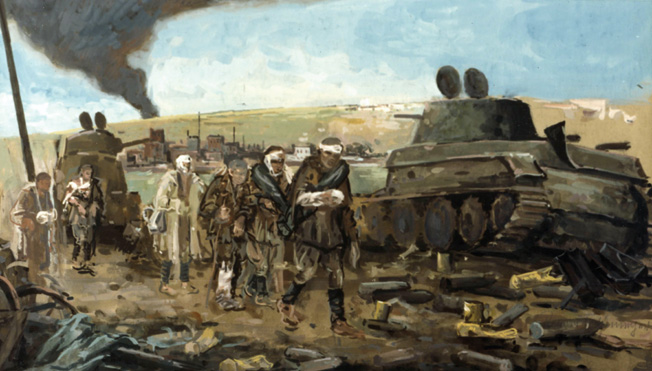
600,000 Casualties
The price the Soviet people paid for this respite was prohibitively high. While German losses were approximately 80,000 men, the Red Army suffered over 600,000 casualties, including almost 400,000 men taken prisoner. The fighting strength of five Soviet armies was destroyed, and they had to be reformed practically from scratch. A month after the Battle of Smolensk, seriously wounded Maj. Gen. Mikhail Lukin was taken prisoner during the disastrous campaign at Vyazma. With his right arm partially paralyzed and his right leg amputated at the knee, the tenacious general survived the war in Nazi captivity. He returned to the Soviet Union after the war and was briefly reinstated in the army before medically retiring in 1947.
Three bloody years later, Zhukov, Konev, and Rokossovsky came through this area again, this time pushing the German Army westward. In a reversal of fortune, they were instrumental in the destruction of their old nemesis, German Army Group Center.
Back to the issue this appears in
Join The Conversation
Leave a reply cancel reply.
You must be logged in to post a comment.
Share This Article
- via= " class="share-btn twitter">
Related Articles
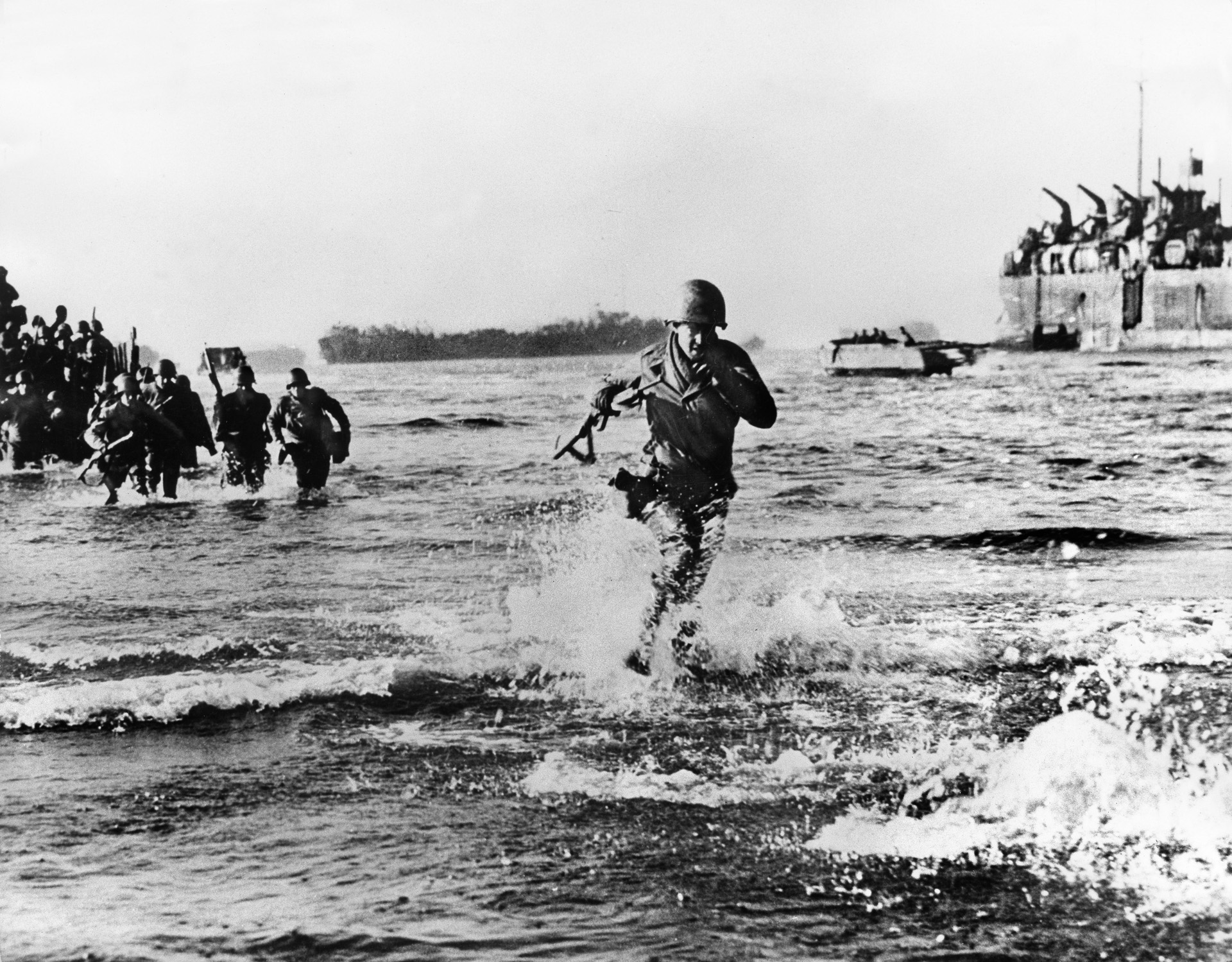
European Theater
Prudence or Paralysis?
Military Museums
The National D-Day Museum highlights the War in the Pacific via major expansion.
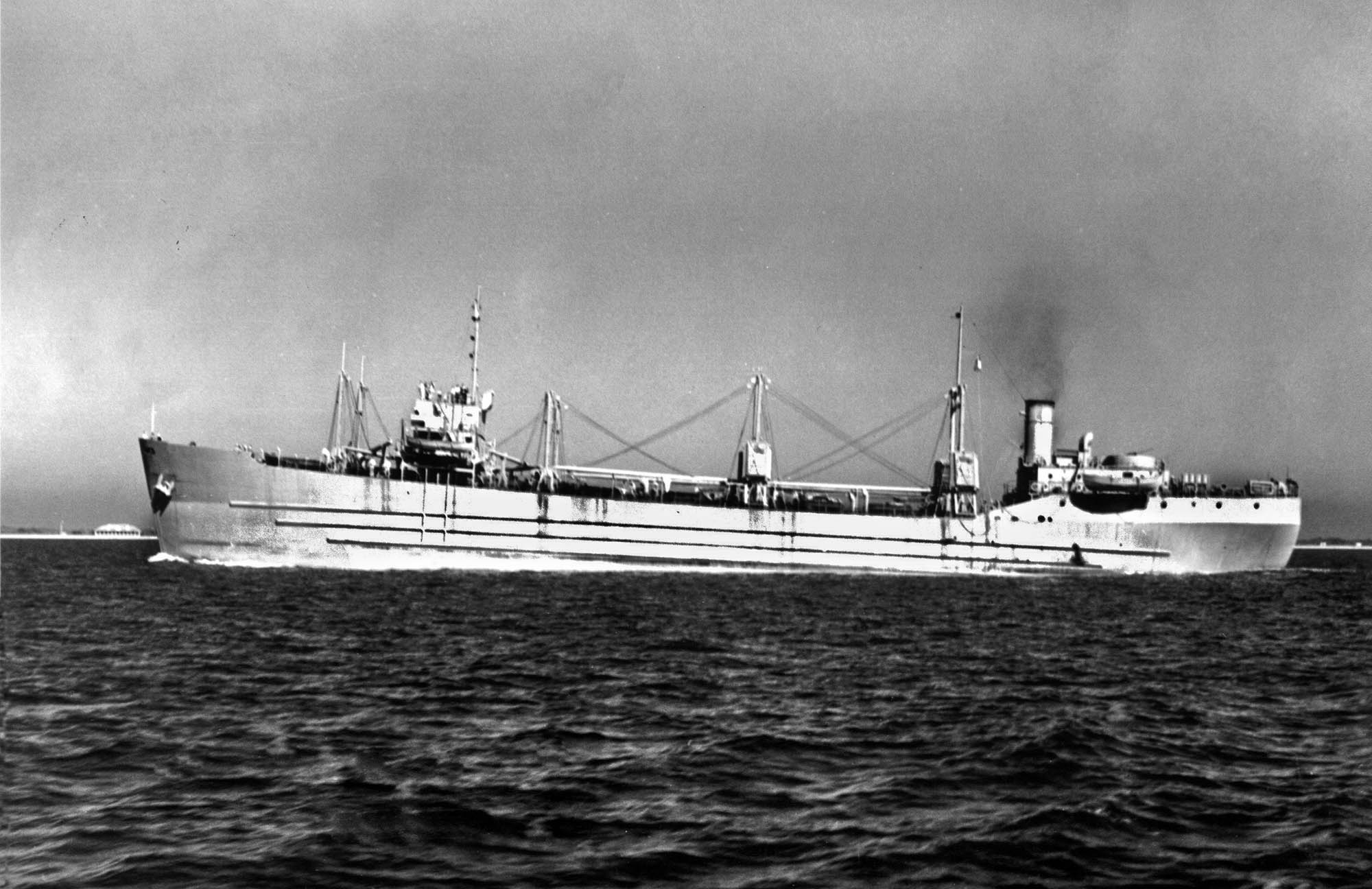
The Concrete Fleet of WWII
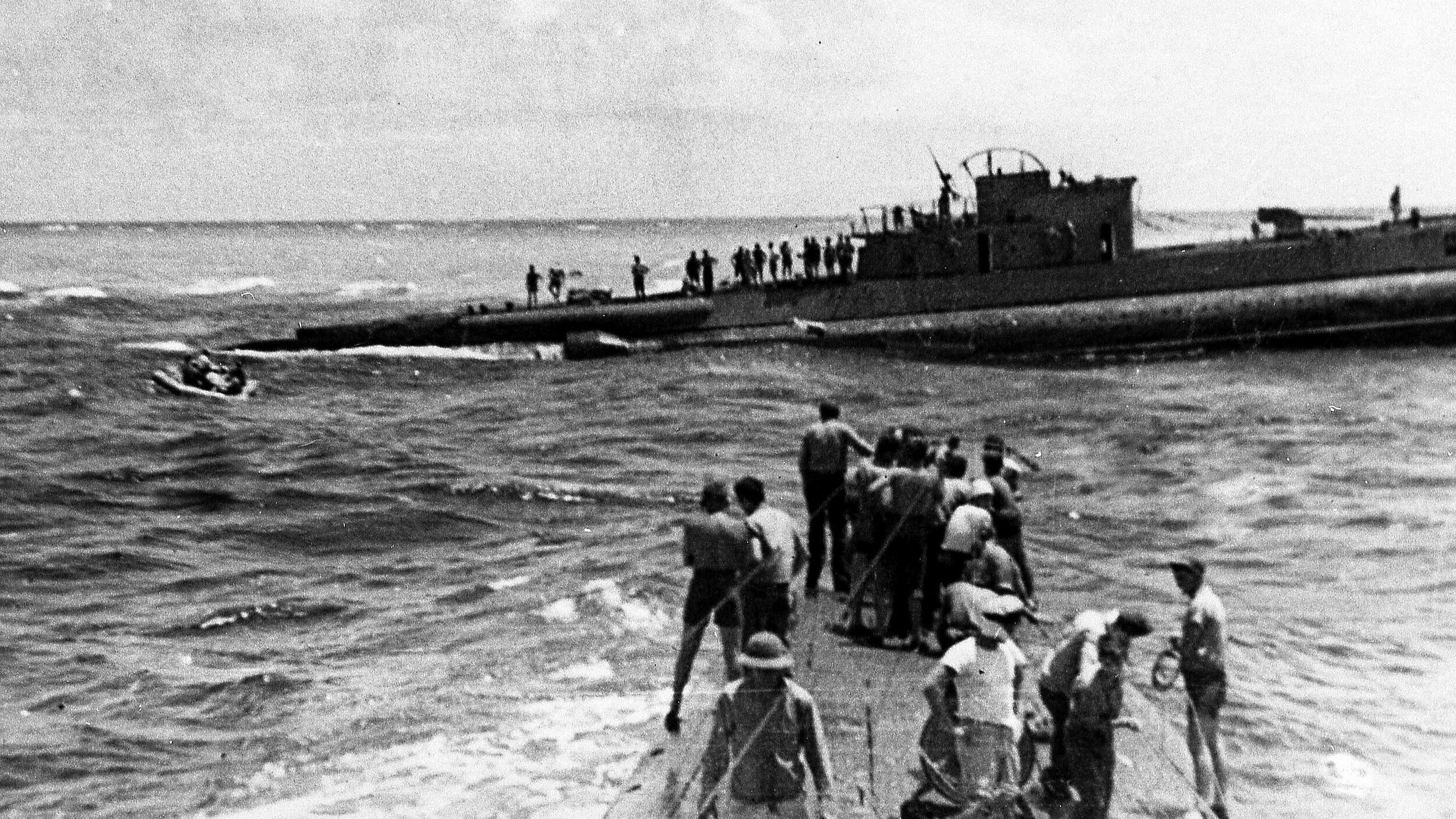
Rescue at Ladd Reef
From around the network.
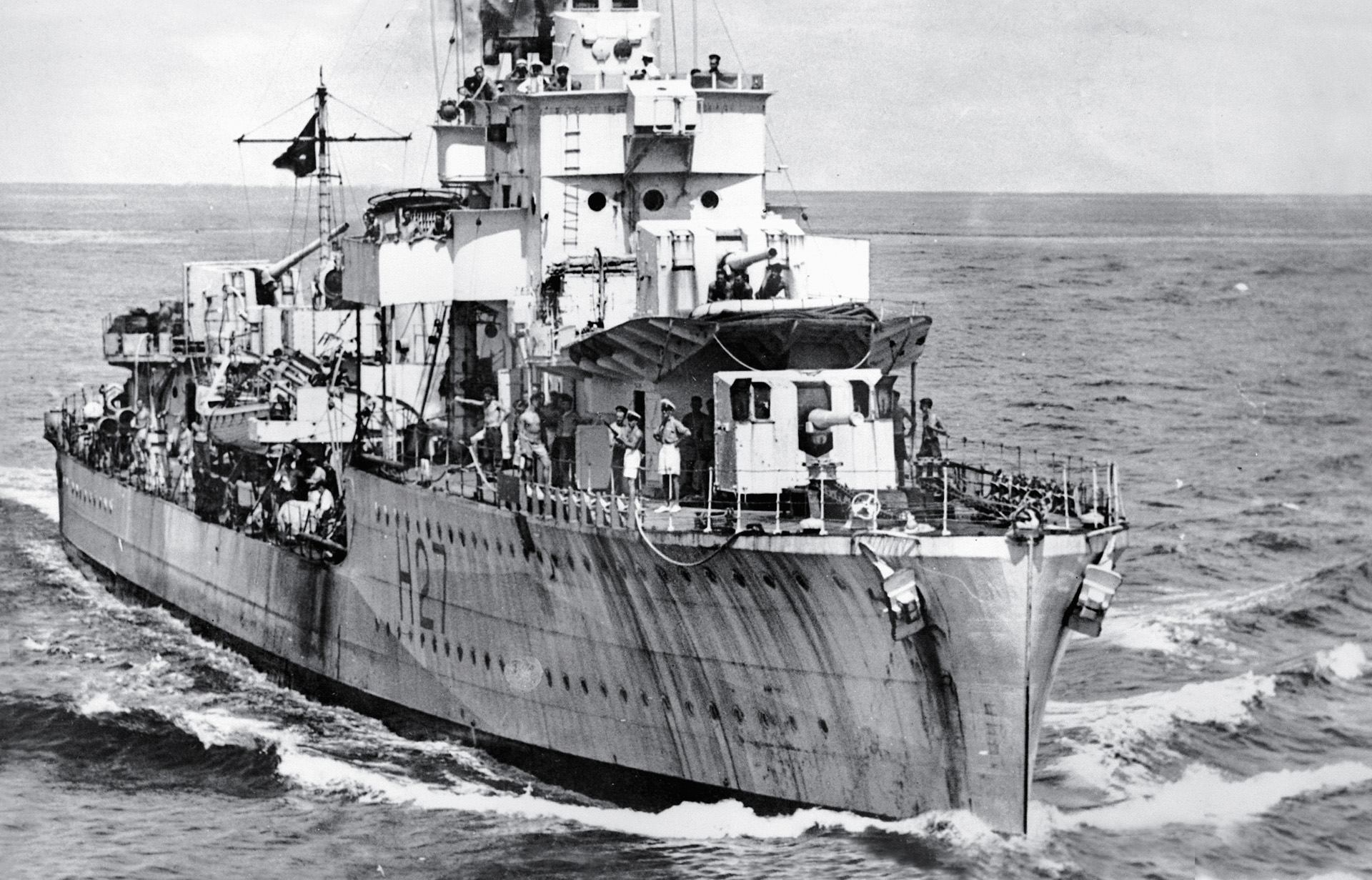
Famous Navy Ships: The HMS Electra
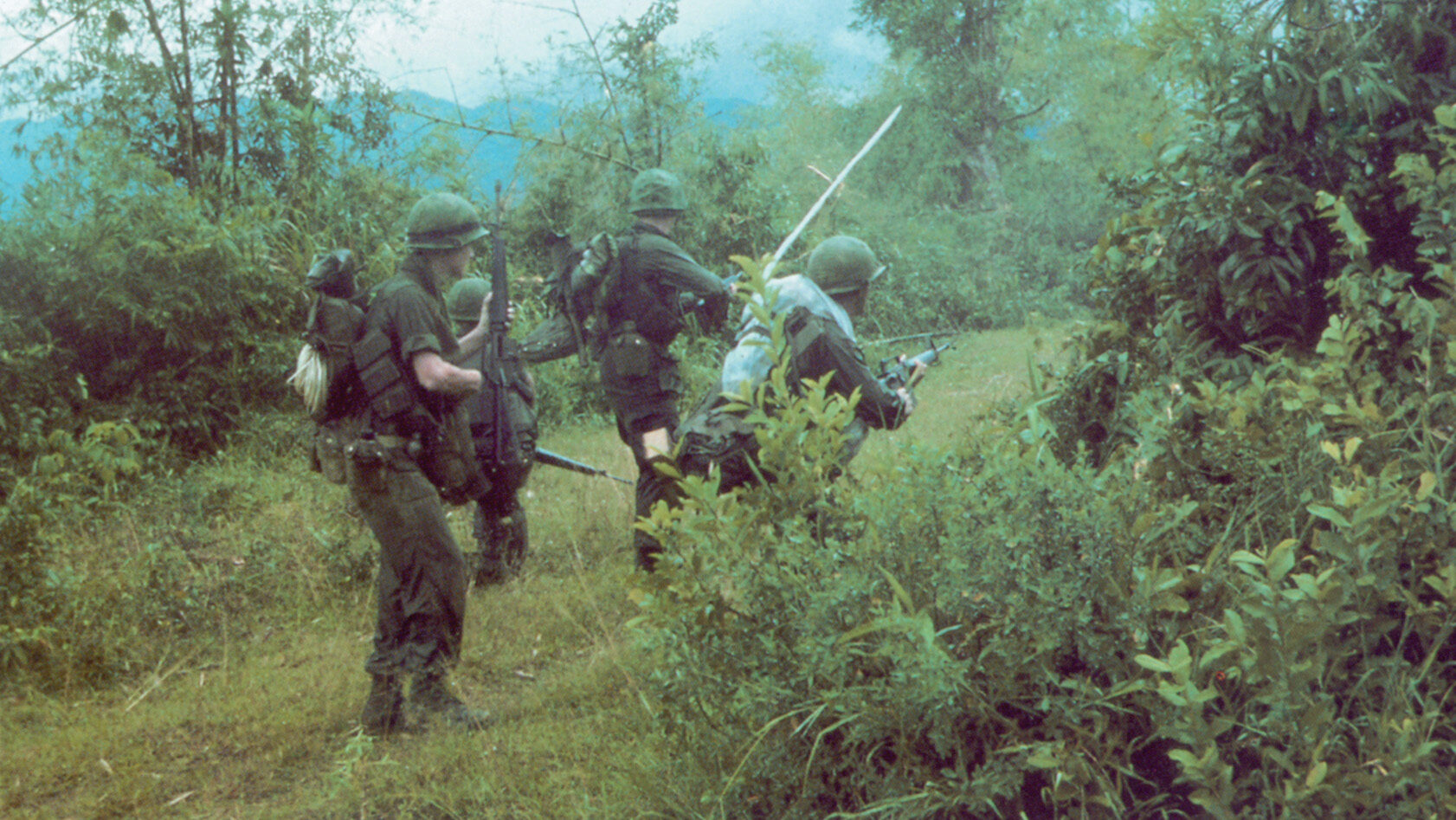
Military History
Helmets of the Superpowers—Soviet and American— attract collectors.
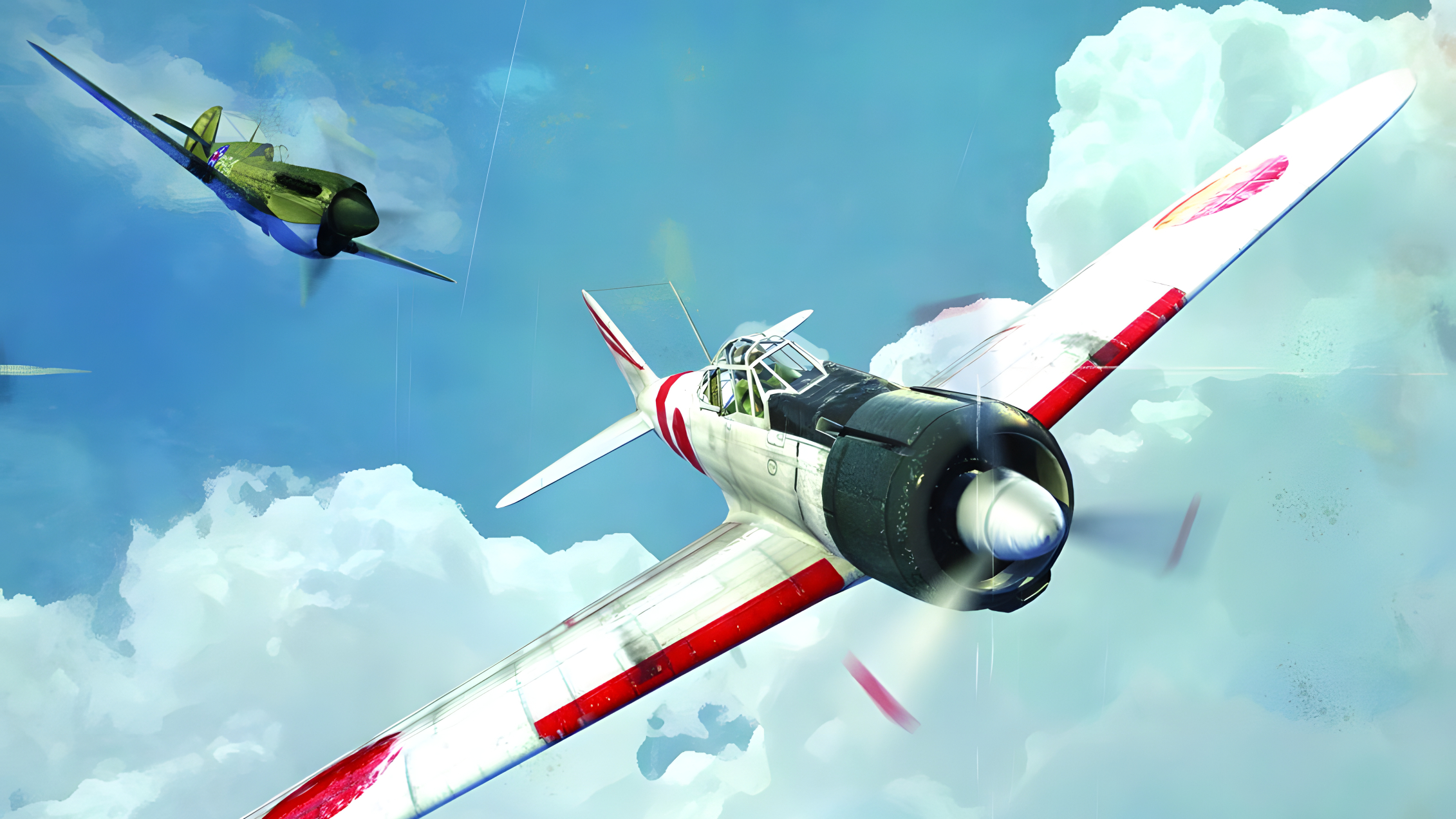
Military Games
Pearl Harbor Trilogy: Red Sun Rising
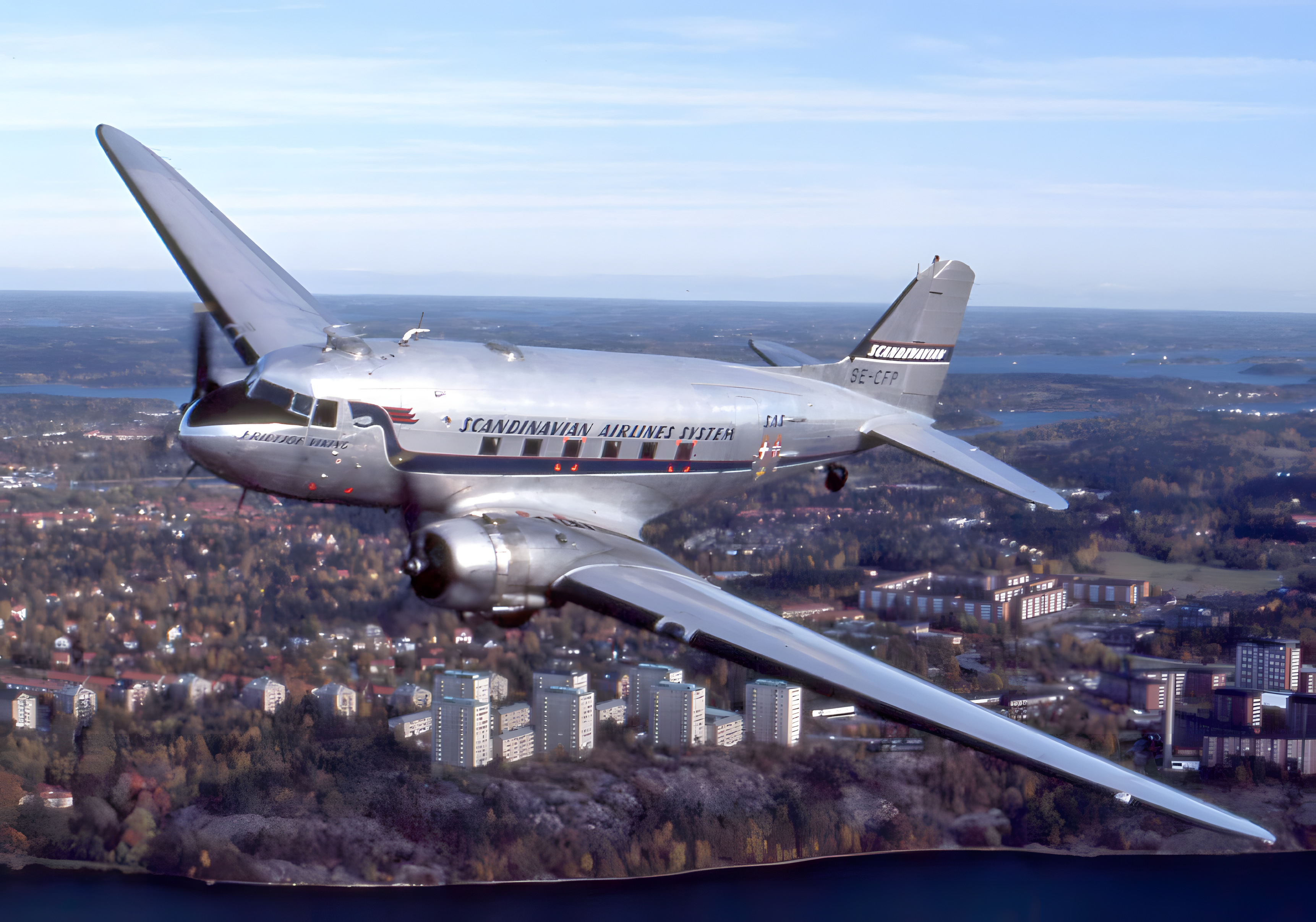
Luftwaffe Attacks Civilian DC-3

Bar and Restaurant
At royal lymington yacht club.
Our restaurant, bar and sun terraces provide arguably the most picturesque views of the Lymington River and the Solent shore. Our family-friendly restaurant serves locally sourced, high quality nourishing food at affordable prices. Please note our bar and restaurant take card payment only (no cash).
Opening hours - Winter Season
*** please note that on valentine's day lunch time, we are only offering our set valentines menu.***, book a table:.
If you are members of our Club and you wish to make a reservation for a group of less then eight then please use our online reservation option via the button below, alternatively you can email [email protected] or call 01590 671751.
Online Reservation
Royal Lymington Yacht Club welcomes new Members including experienced sailors and those new to the water.
We host regular keelboat and dinghy racing, Club events and large-scale National and International regattas.
For those who travel in a more relaxed manner afloat, our cruising section boasts a fine and varied selection of activities.
Motor Boating
Join our growing power boat section on regular motor cruises.
Our Bar and Restaurant
Affordable and family-friendly bar and restaurant with spectacular views!
Junior and Youth
A prominent RYA training centre, we provide regular training courses, regattas, championships and events.
Our flexible space and stunning views are the perfect venue for conferences, celebrations and other events.
Our flexible space and stunning views are perfect for conferences, celebrations and other events.

IMAGES
COMMENTS
Royal Lymington Yacht Club Bath Road Lymington SO41 3SE Tel: 01590 672677 Email: [email protected] Quick Links. Join Us ... Open Day 2024; About. Club Facilities; Club Success; Crane Services; Job Opportunities; Member Benefits; ... Royal Lymington Yacht Club Bath Road Lymington SO41 3SE Tel: 01590 672677 Email: [email protected]
Royal Lymington Yacht Club Open Day. Representatives from many areas of the club will be on hand during the Open Day to show visitors around and a selection of members' boats will be available to view. 10:00 to 14:00 - Discover the Club's history in their centenary year
The Royal Lymington Yacht Club (RLymYC) will be hosting its annual Open Day and 'Crew Match' on Saturday 26th March to introduce the fun of sailing and boating to as many people in the community as possible. The Open Day will take place from 10am to 4pm at the RLymYC clubhouse in Bath Road, Lymington, with the Crew Match Morning taking place ...
Sports event in Lymington, United Kingdom by Royal Lymington Yacht Club on Saturday, March 26 2022
ROYAL Lymington Yacht Club have confirmed details for their upcoming 2024 open day. Taking place at Bath Road, the open day and crew match has been scheduled for Sunday, March 17, between 10am and ...
Royal Lymington Yacht Club, home of sailing, motor boating, yachting and water sports, welcomes new members. Skip to content. Tel: 01590 672677. Member Login Page content. Royal Lymington Yacht Club ... Join our day sails, weekend meets and longer cruises in the Solent and beyond. CRUISE WITH US!
Open Day & Crew Match 2024 Sunday 17th March 2024 10.00 till 14.00 ... Royal Lymington Yacht Club Bath Road Lymington SO41 3SE Tel: 01590 672677 Email: [email protected] Quick Links. Join Us Racing Cruising Motorboating Crew Register Club Racing Results Junior & Youth Sailing
Come and find out about the Royal Lymington Yacht Club at our Open Day on Saturday 26th March 2022 from 10am to 4pm. We welcome new members of all ages. Skip to content. Tel: 01590 672677. Member Login Page content. False. Club Open Day 3rd June. 15/05/2023 15:46:52 Open Day for everyone interested in boating on the Solent ...
Open Day. Everyone is welcome and no prior boating experience is required to join the RLymYC and take part in the huge number of activities on offer. Representatives from many areas of the club will be on hand during the Open Day to show visitors around and a selection of members' boats will be available to view. 10:00 to 16:00
Experience first class cuisine and exceptional service in our fabulous restaurant and enjoy drinks and our all-day menu in our bar or on our sun terrace, with stunning riverside and Solent views. To reserve a table, please contact the club office on 01590 672677 or email [email protected].
The Royal Lymington Yacht Club aims to be successful on the water, friendly and welcoming ashore. Every year, we run something over 200 days of organised sailing events, we start over 400 races and run a dozen or so open events which attract over 800 entrants. Our keelboats compete at national level and our members are regular prize winners in ...
The Royal Lymington Yacht Club is one of the most active 'Royal' Clubs, founded in the hopeful days after the first World War. Royal status was bestowed on the Club in 1936, which complemented the Royal patronage of the Club since 1925. The First Patron was HRH Prince Henry, Duke of Gloucester, the uncle of HM The Queen.
Royal Lymington Yacht Club, home of sailing, motor boating, yachting and water sports, welcomes new members. Skip to content. Tel: 01590 672677. Member Login Page content. Royal Lymington Yacht Club The home of yachting, dinghy sailing and motor boating. ABOUT US. Celebrating our Centenary in 2022. OUR CENTENARY ...
The aim of the club was to provide regular racing between June and September for a Handicap class, the Solent Sea Birds and the Prams. The first gun of the first race was fired on Saturday 3 June 1922. The Duke of Gloucester became Patron of the Club in December 1931 and the Royal Warrant was granted by King George VI on 3 November 1938.
Visit Royal Lymington Yacht Club's open day on Saturday 26th March between 10am and 4pm to find out more about the Club and getting into boating! Related Articles The Wise Man of the Solent Osprey and Moth champion Tony Blachford passed away in December Although nominally a single-hander, Tony Blachford was ...
The previous post in this series described how Napoleon decided to retreat from Moscow on 18 October 1812. His intention was to make for the supply depot at Smolensk by a southerly route. This might require a battle with Mikhail Kutuzov's Russian army, but would mean that the French were not moving through the territory that had been ravaged in their advance on Moscow.
Royal Lymington Yacht Club, home of sailing, motor boating, yachting and water sports, welcomes new members. Skip to content. Tel: 01590 672677. Member Login Page content. Royal Lymington Yacht Club ... Bookings are open for a very special Valentine's Day lunch and supper. In the evening you will be serenaded by a live pianist and for £49.95 ...
To this day Smolensk has some of the oldest churches in Russia, such as the Church of Sts. Peter and Paul (built around 1146), the Church of St. John the Divine (1160s), and the majestic Church of ...
at Royal Lymington Yacht Club. Our restaurant, bar and sun terraces provide arguably the most picturesque views of the Lymington River and the Solent shore. ... *** Please note that on Valentine's Day Lunch time, we are only offering our set Valentines Menu.*** ... Monday & Tuesday. Bar open 10:00 - 1500: Wednesday - Saturday: Bar open 09.30 ...
The strategic importance of Smolensk was reaffirmed by Tsar Boris Godunov (1551-1605), who saw it as a bulwark against Poland and undertook a fundamental rebuilding of the city walls between 1595 ...
Royal Lymington Yacht Club Bath Road Lymington SO41 3SE Tel: 01590 672677 Email: [email protected] Quick Links. Join Us Racing Cruising Motorboating Crew Register Club Racing Results Junior & Youth Sailing Wednesday Junior Sailing Crane Services RYA Training Venue Hire Organise A Sailing Event
Known as the "Smolensk Gates" in Russia, the 45-mile wide neck of land between the headwaters of the Dvina and Dniepr Rivers was the traditional invasion route from central Europe into the heart of Russia. This road had been taken in the 17th century by the Polish Army, resulting in the capture of Moscow. In 1812, Napoleon fought a battle ...
*** Please note that on Valentine's Day Lunch time, we are only offering our set Valentines Menu.*** Monday & Tuesday. Bar open 10:00 - 15:00 : Wednesday - Saturday: Bar open 09.30 - 23.00 Lunch: 12.00 - 15.00 Dinner: 18.00 - 21.00: Sunday: Bar Open: 09.30 - 17.00 ... Royal Lymington Yacht Club welcomes new Members including experienced ...